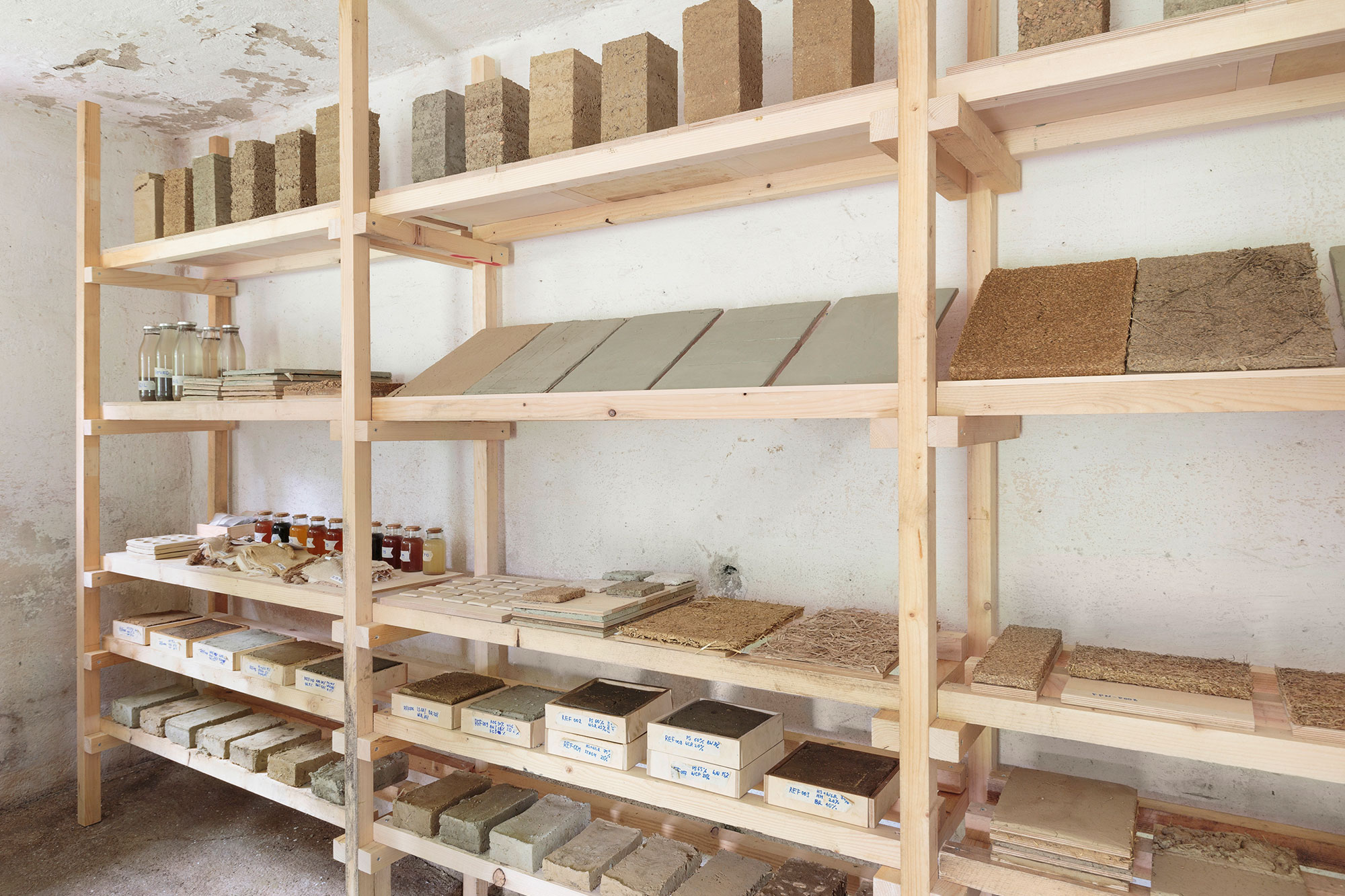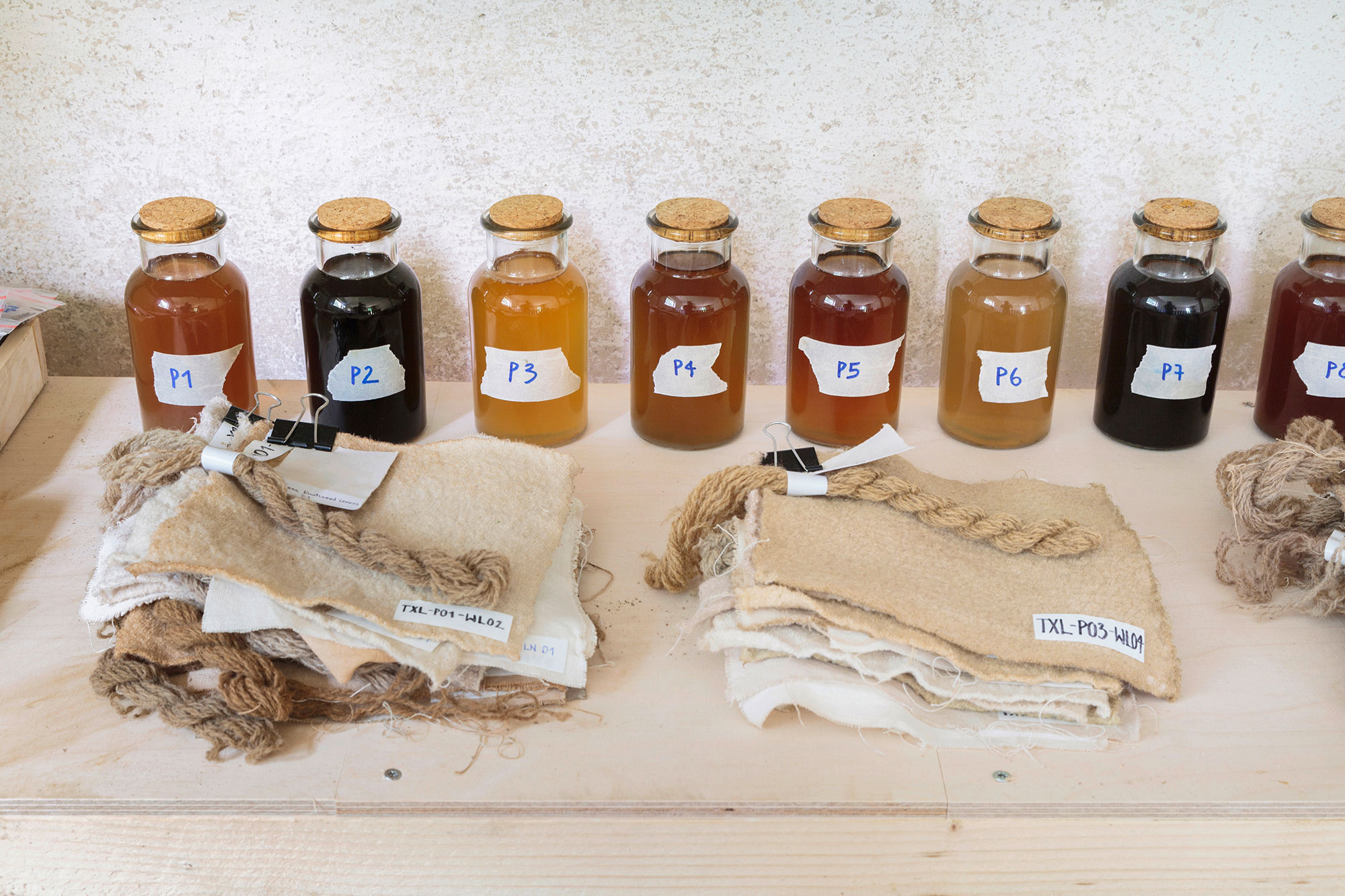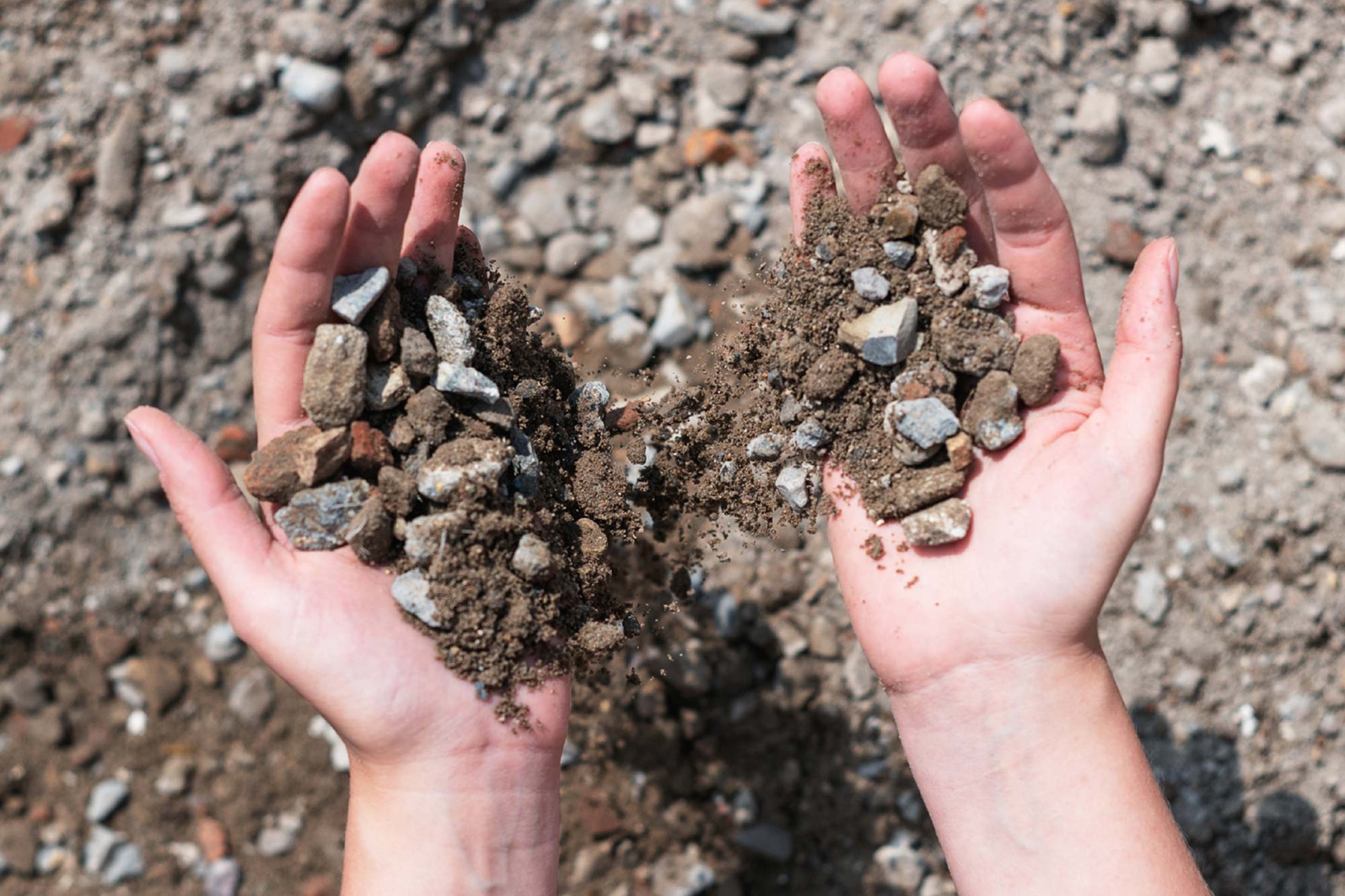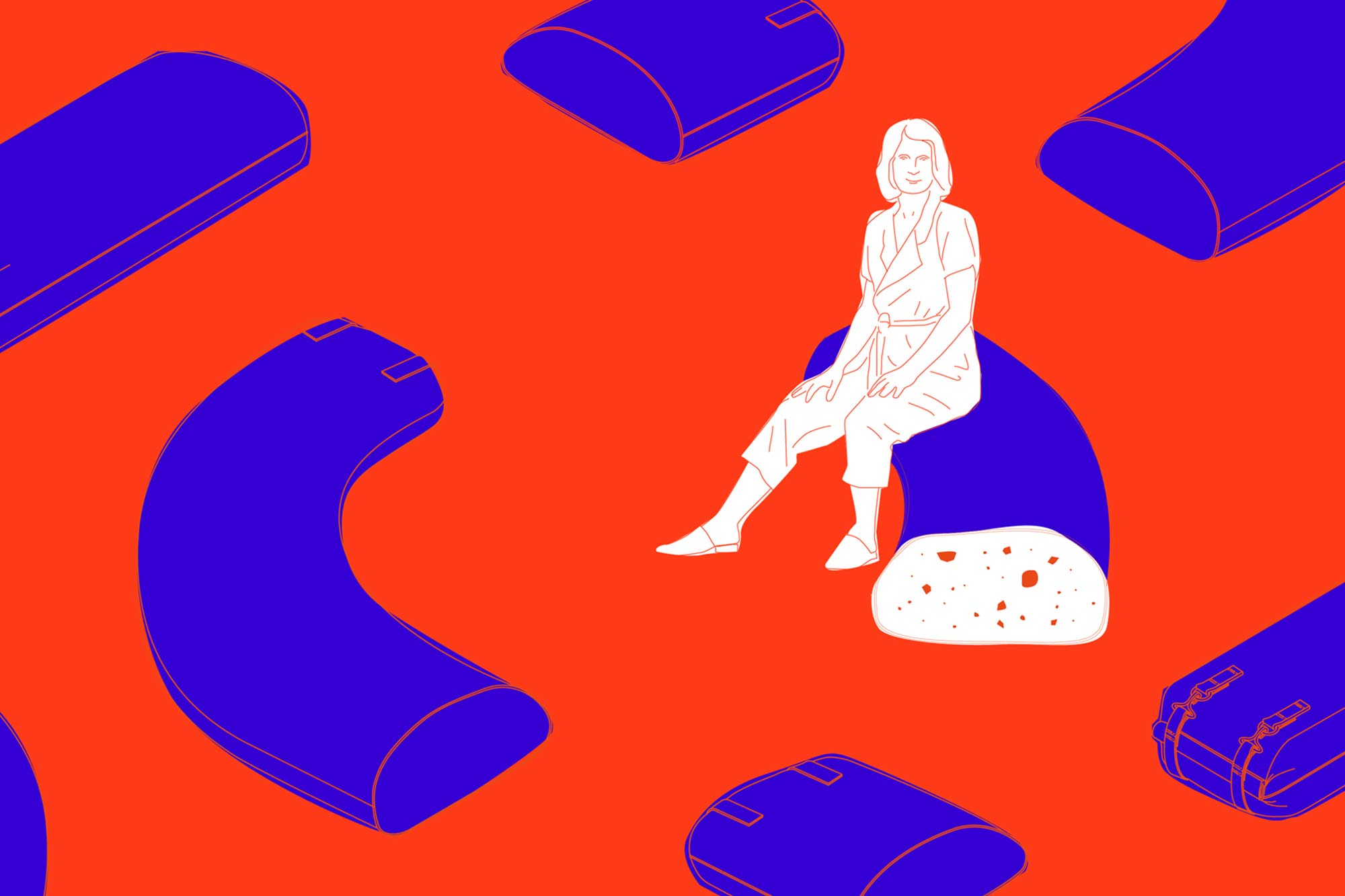Culture in Residency: Material Library
As part of the LINA Fellowship and collaboration with the Institute of Architecture and Design, Estelle Jullian, Thomas Amann, and I held a workshop with the Architecture students of TU Vienna that mapped out the ecological and industrial material landscape around the Campus of the Vienna Boys’ Choir. From these resources the students developed material recipes that would apply these so-called waste streams in a library of local architectural materials.

The Material Library has now permanently moved into the pig sty on the Campus of the Vienna Boy’s Choir in Sekirn, Austria, to inspire and inform future workshops.
How can we live – and create – on a damaged planet? If, as the philosopher Baptiste Morizot describes, the ecological crisis is also a crisis of sensitivity, how can we feel, understand and weave new relationships with respect to the territory and the matter of the objects that constitute our own daily life and the more-than-human life that surrounds us? As the architect tests the role of the mediator to help foster these connections, which tools, methodologies and (knowledge) collaborators are needed and which architectural possibilities spring from this framework?
The slowly deteriorating existing buildings and varied landscape of the Vienna Boys’ Choir campus offer a testing ground for radical strategies of adaptive reuse through local resources and material waste streams. The workshop explored the local landscape that is characterized by its partially natural and its partially industrial material and waste streams. The students mapped these local material streams directly on the territory and in regional proximity to Sekirn to trace the resources for our workshop.

The library includes several died textile samples and liquid pigments extracted from local invasive plant species.
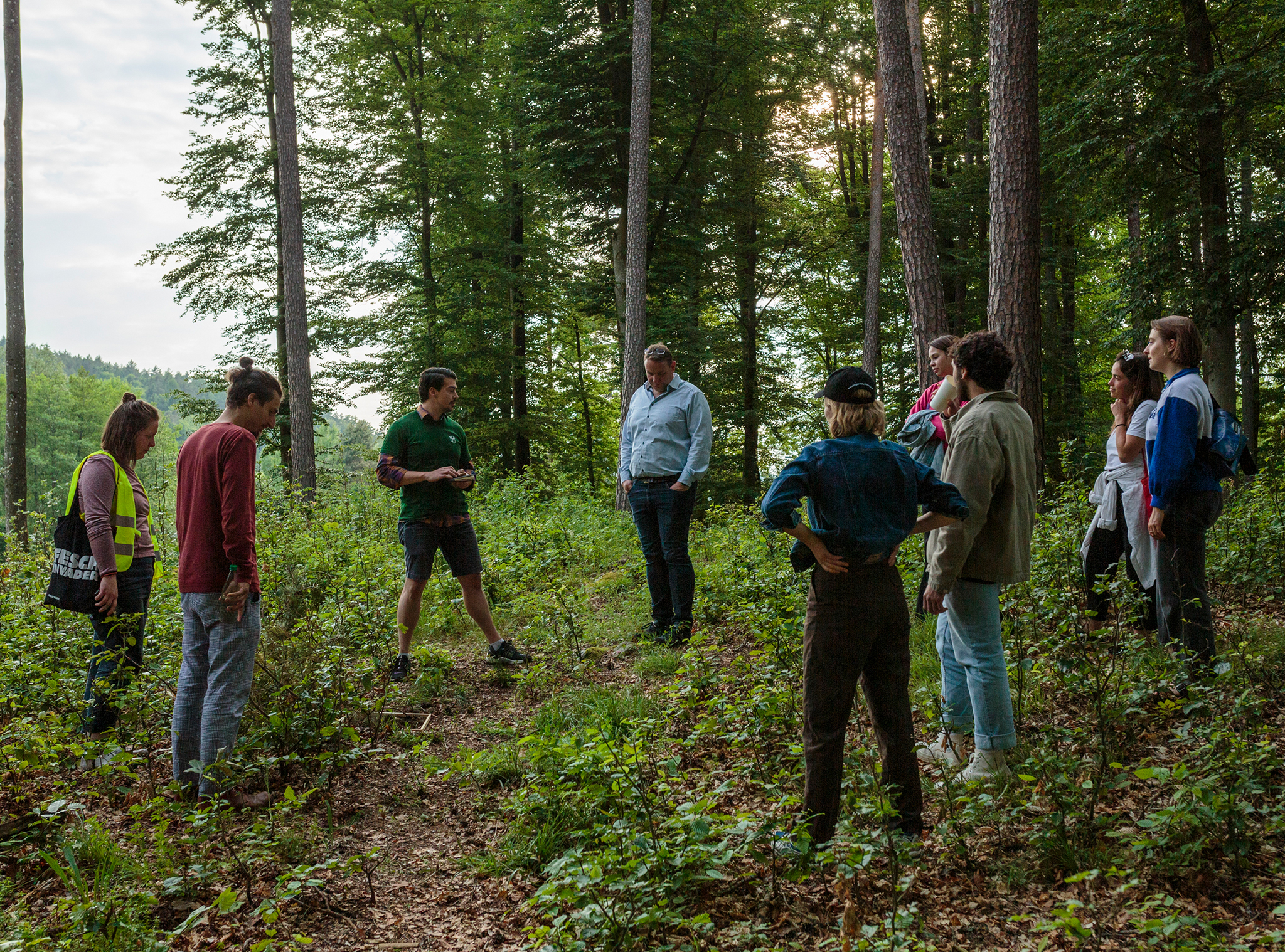
The Material Library is closely connected to the territory that houses it. Tours of the territory reveal these connections between the local ecology of the soil, lake and forrest to the material palette.
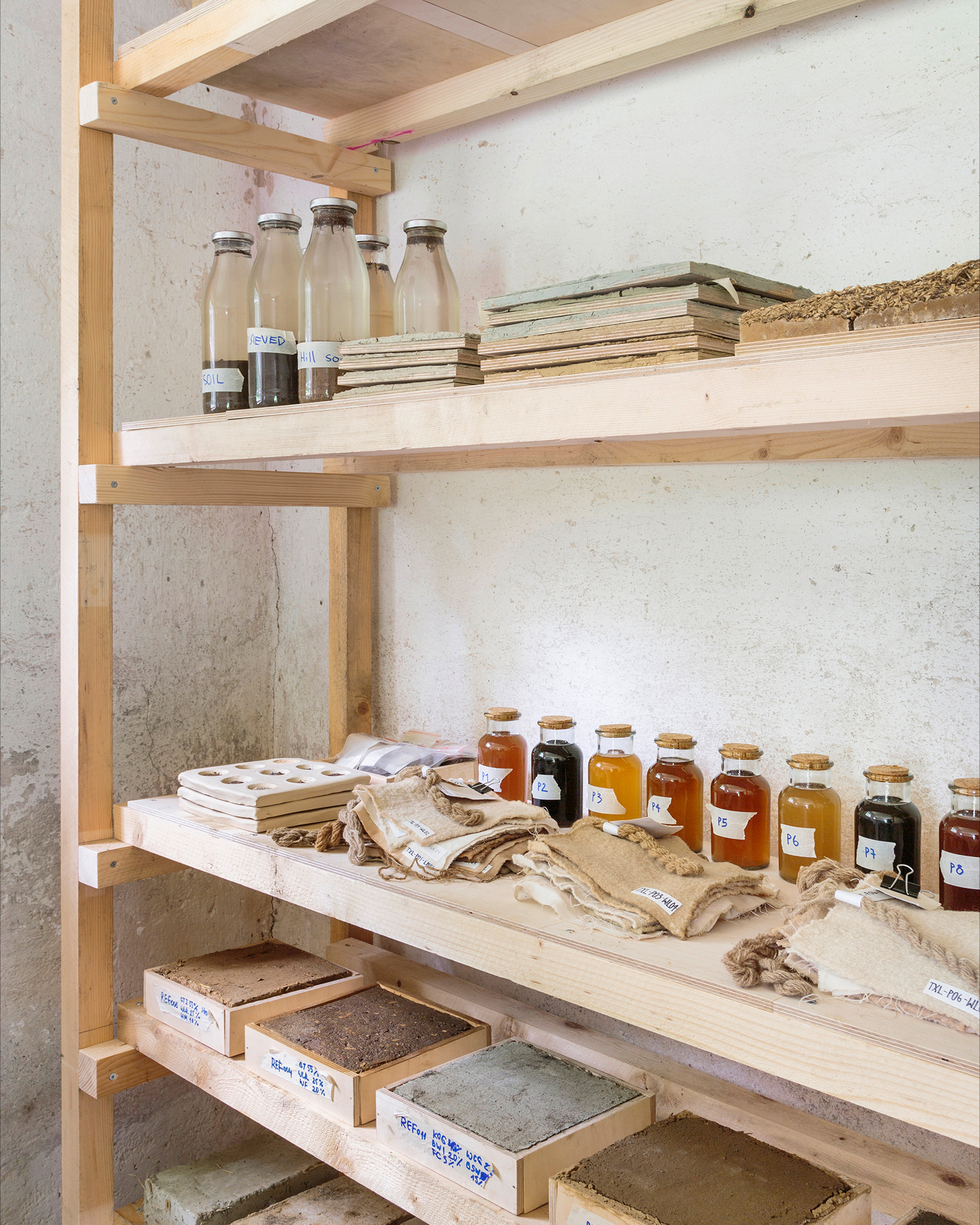
The samples contain both successful and failed experiments to inform future material research.
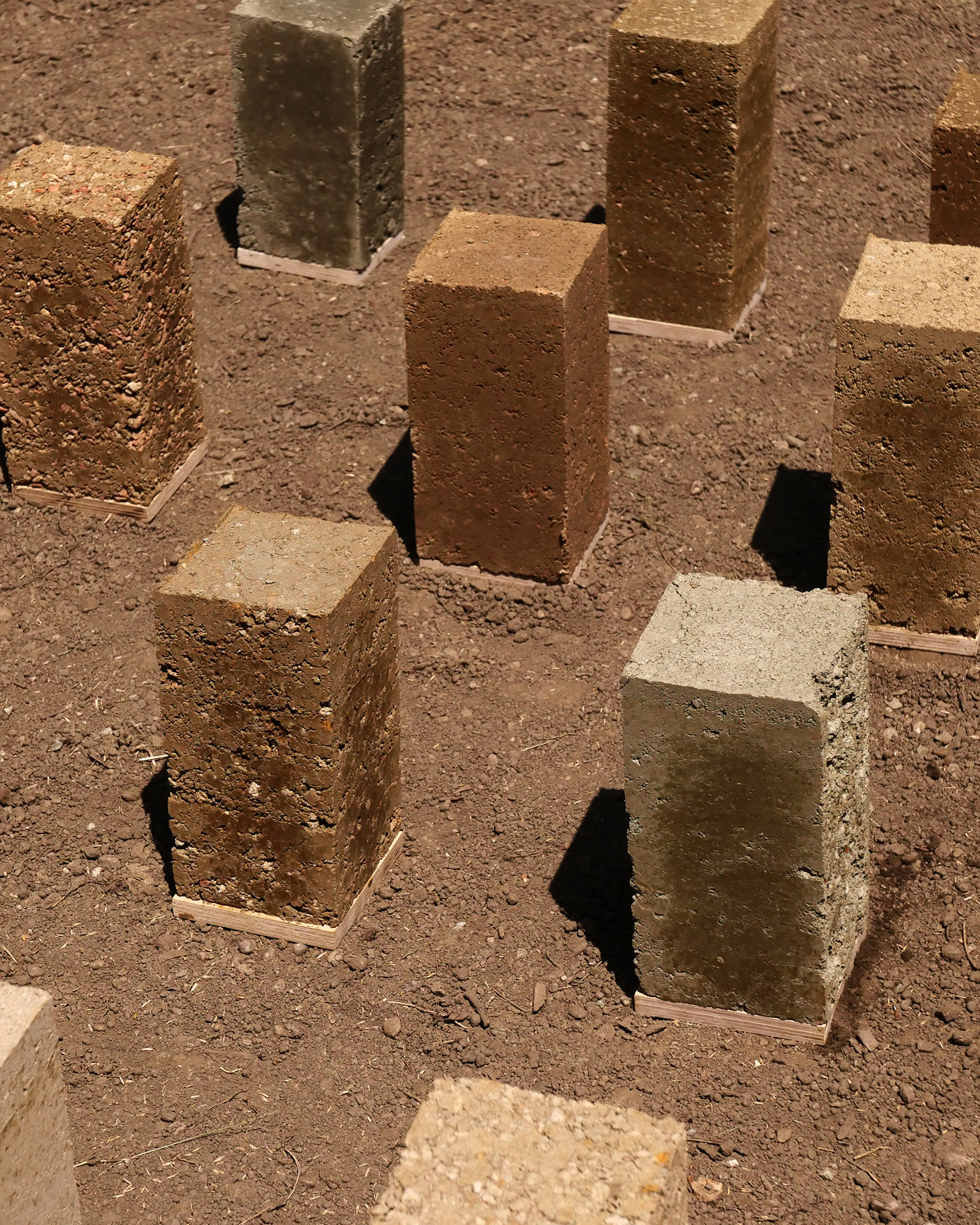
The students tested the use of crushed brick waste, stone dust, and mixed crushed construction waste among other local material streams in the development of a local rammed earth recipe.

All recipes began with a collection of raw material samples from agricultural and industrial (waste) material streams like the invasive Japanese knotweed, waste sheep wool, or crushed construction waste.
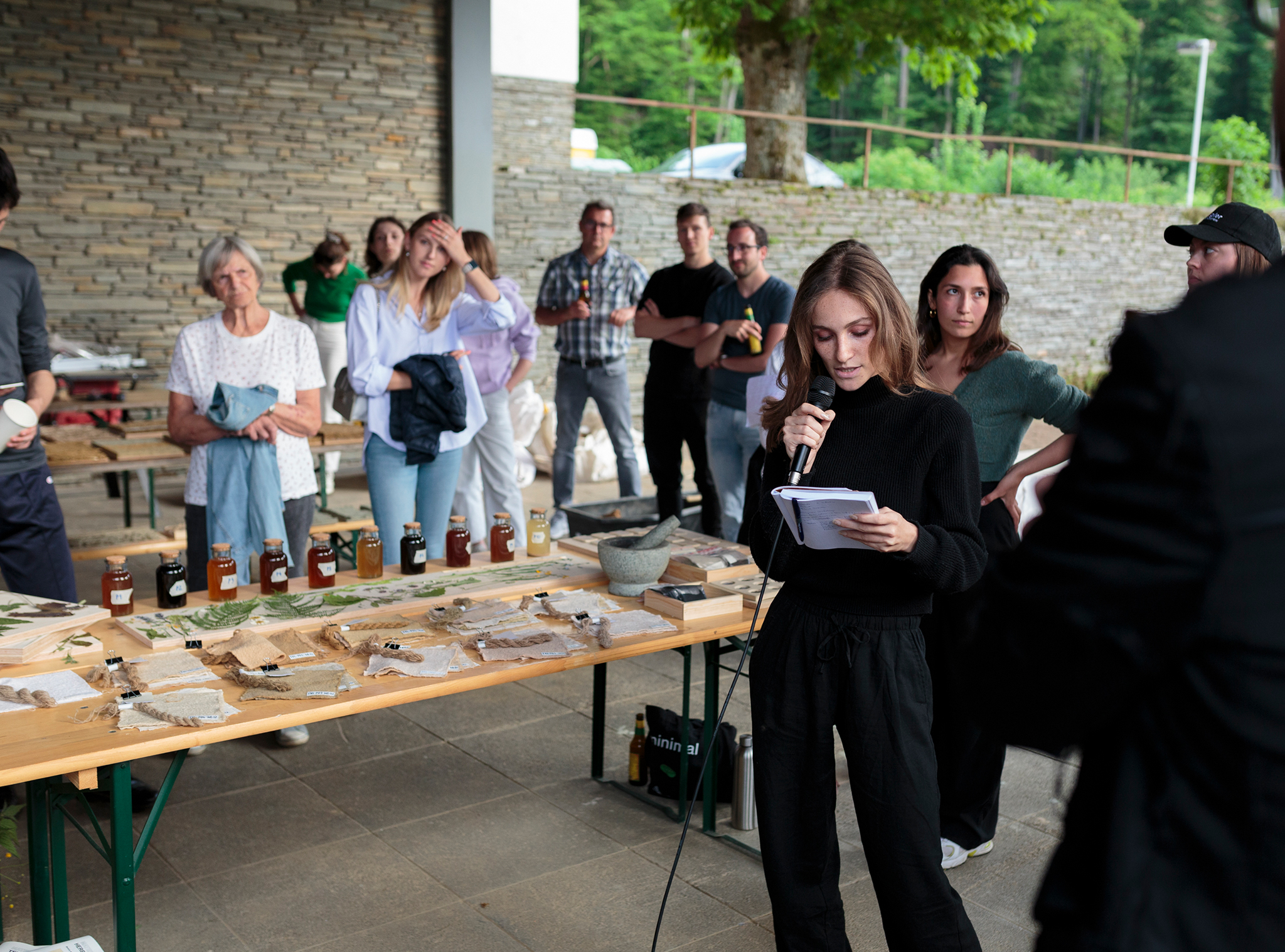
At the opening of the Material Library, the students guide their material partners, neighbours and tutors through their process.
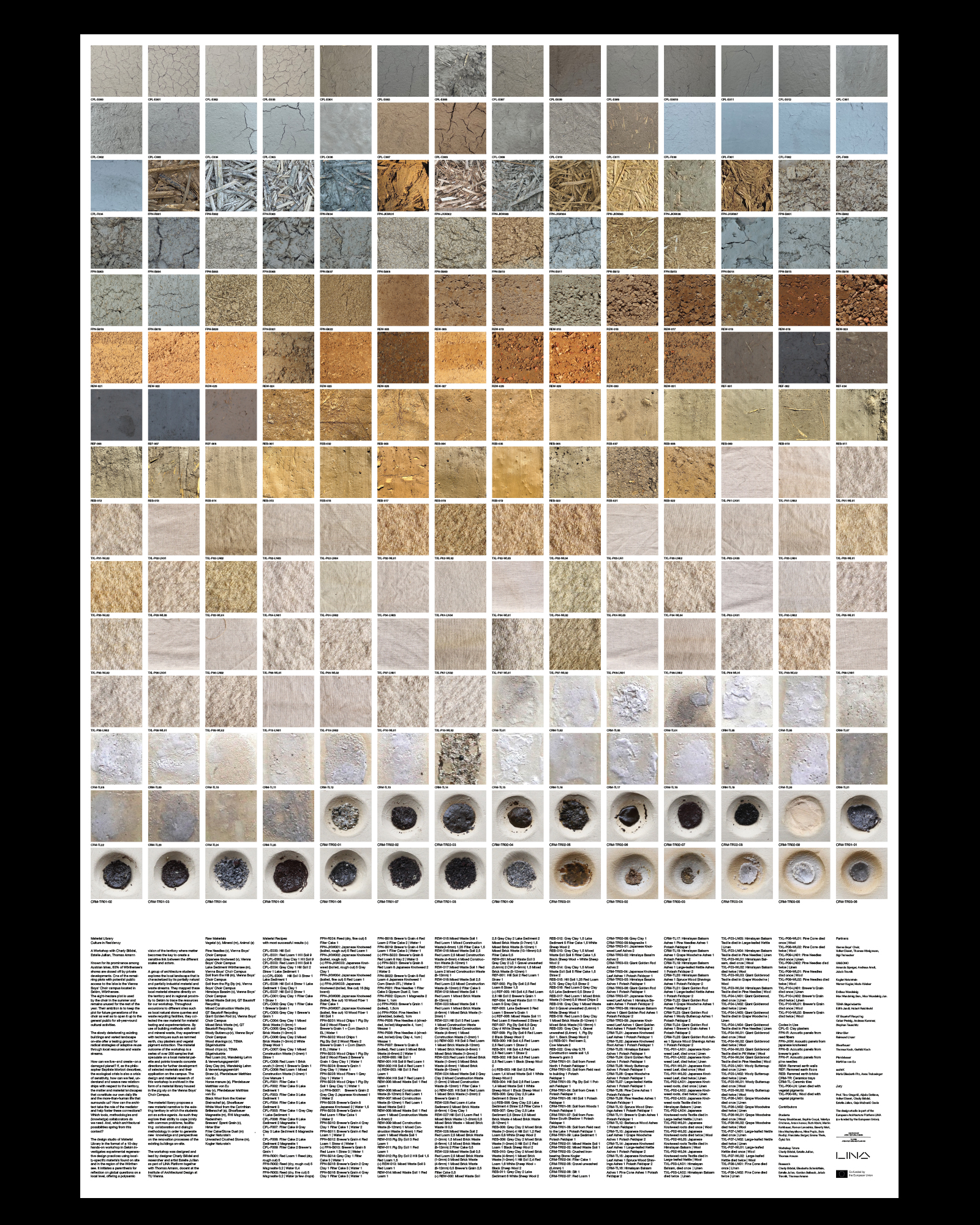
All material recipes, both failures and successes, are noted and archived in a recipe poster.
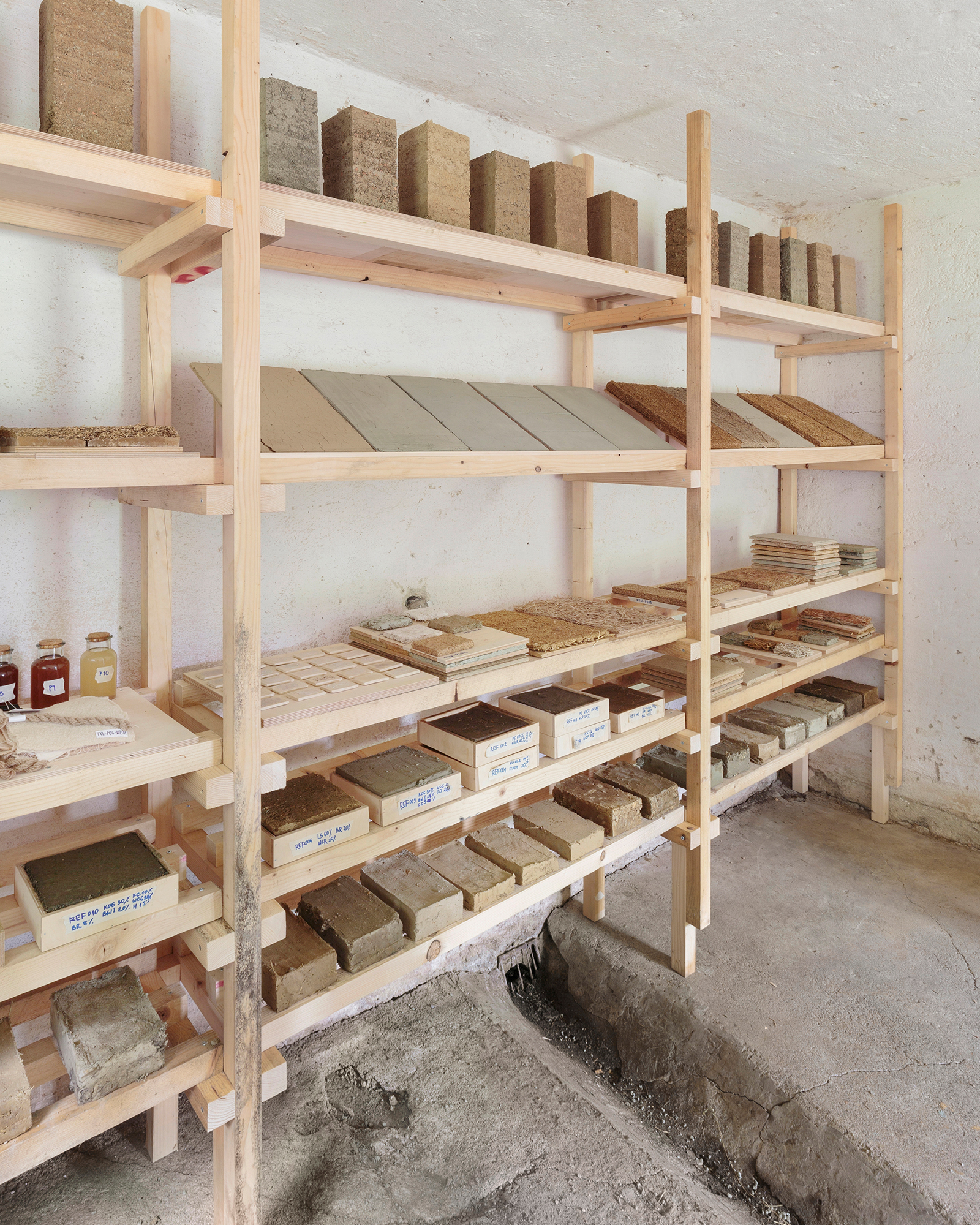
Throughout excursions to different sites such as local natural stone quarries and construction waste recycling facilities, we collected the raw material for material testing and experimentations. The outcome of the workshop is a series of material samples that speculate on a local material palette. These samples point towards concrete directions for further development of selected materials and their application on the campus. The design and material research of this workshop is archived in the form of a library for local material recipes which will be housed at the pig sty of the campus for future use and further exploration.
The material library proposes a new material narrative to the existing territory in which the students of TU Vienna act as active agents in coping jointly with common challenges, facilitating collaboration and dialogic methodologies in order to generate and draw on new knowledge(s) and perspectives in the specific context of the renovation processes on the Vienna Boys’ Choir campus.
Students
Fanny Bruckbauer, Sophie Coqui, Valeriya Gridneva, Anton Ivanov, Ruth Köchl, Martin Kohlbauer, Roman Levoshka, Beverly Mori, Irina Mezheynikova, Nina Popic, Sara Rodiqi, Franziska Sorger, Emma Theis, Öykü Tok
Workshop Tutors
Charly Blödel, Estelle Jullian, Thomas Amann
Jury
Prof. Tina Gregorič Aljoša Dekleva, Volker Dienst, Tina Gregorič, Estelle Julian, Gaja Mežnarić Osole
The design studio is part of the European Architecture Platform LINA (co-funded by the European Union).

© Charly Blödel, 2022. For more Imprint.
Building with Waste Streams
During a 10-day workshop developed with Estelle Jullian (LINA fellow) and Thomas Amann (TU Vienna), the Architecture Master Students mapped local agricultural waste streams and industrial byproducts in natural stone quarries, construction waste recycling facilities and wood manufacturers. Through material tests and prototyping, the students developed new material recipes that apply these material streams in a local architectural material palette, from recipes for rammed earth walls, bricks, earthen floors to ceramic Glaces and textiles died with invasive plants.

The quarry of Kogler Naturstein offers a range of products from natural stone slabs and crushed stone in various sizes. When stone is crushed and machines are cleaned, a fine stone dust is filtered out of the cleaning water: A filter cake that the students made use of in rammed earth, brick and plaster mixtures.
How can we live – and create – on a damaged planet? If, as the philosopher Baptiste Morizot describes, the ecological crisis is also a crisis of sensitivity, how can we feel, understand and weave new relationships with respect to the territory and the matter of the objects that constitute our own daily life and the more-than-human life that surrounds us? As the architect tests the role of the mediator to help foster these connections, which tools, methodologies and (knowledge) collaborators are needed and which architectural possibilities spring from this framework?

From crushed brick to stone dust and invasive Japanese knotweed the students explore these materials not as agricultural and industrial waste streams but as possible material streams that can be valuable in the development of local architectural materials.
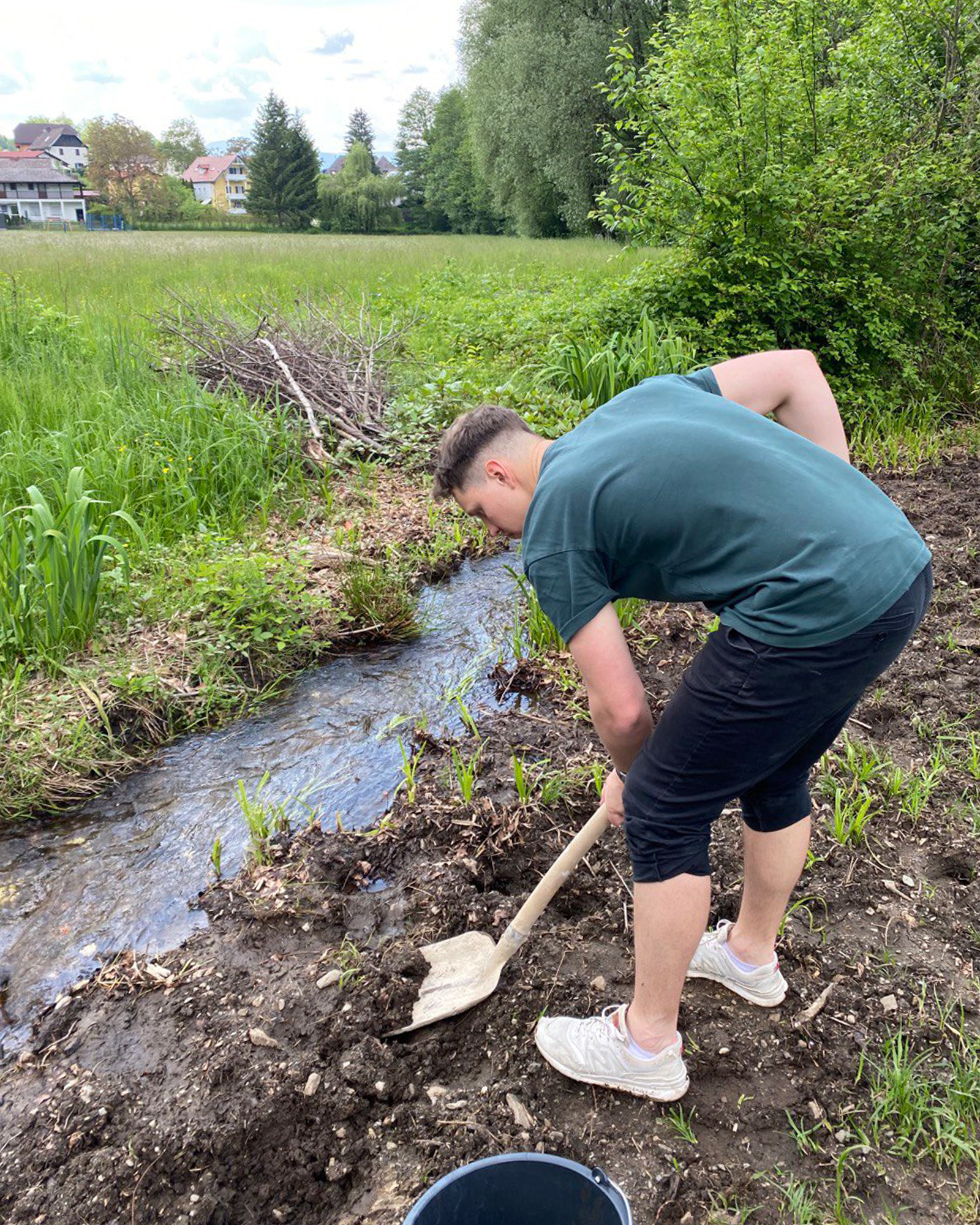
Different kinds of soil can be found on the Campus of the Vienna Boys’ Choir. Each location offers different properties in soils.

With a bottle test the students explore the properties of soils found on the territory of the Campus and waste soils from recycling sites.

The recipes reach from earthen walls and floors to ceramic glazes and died textiles.
The slowly deteriorating existing buildings and varied landscape of the Vienna Boys’ Choir campus offer a testing ground for radical strategies of adaptive reuse through local resources and material waste streams. The workshop explored the local landscape that is characterized by its partially natural and its partially industrial material and waste streams. The students mapped these local material streams directly on the territory and in regional proximity to Sekirn to trace the resources for our workshop.
Throughout excursions to different sites such as local natural stone quarries and construction waste recycling facilities, we collected the raw material for material testing and experimentations. The outcome of the workshop is a series of material samples that speculate on a local material palette. These samples point towards concrete directions for further development of selected materials and their application on the campus. The design and material research of this workshop is archived in the form of a library for local material recipes which will be housed at the pig sty of the campus for future use and further exploration.

Through frequent adjusting of ratios and testing of material properties, the students refine their final recipes.
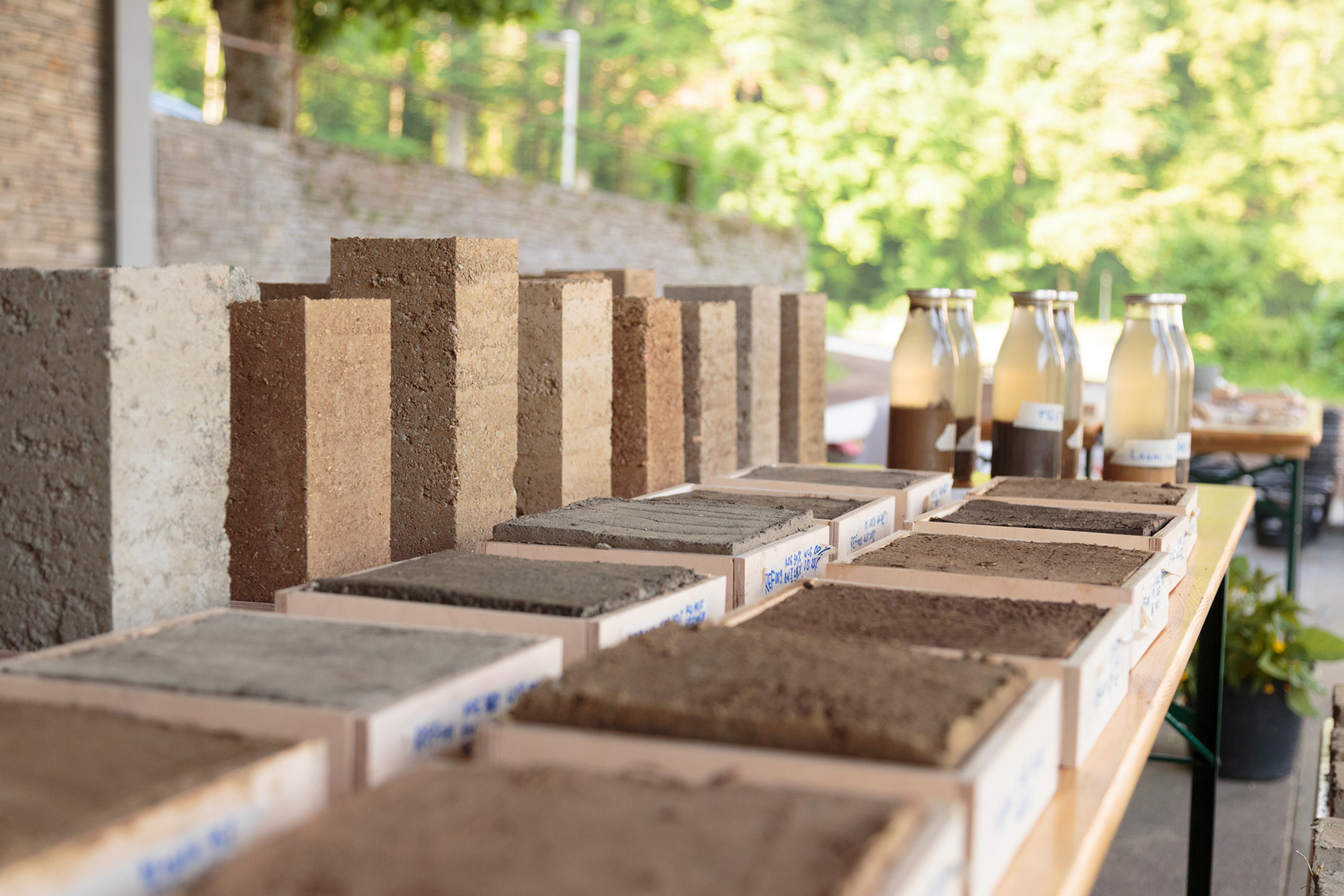
The result: a material library of industrial waste streams applied in a local architectural material palette.
The material library proposes a new material narrative to the existing territory in which the students of TU Vienna act as active agents in coping jointly with common challenges, facilitating collaboration and dialogic methodologies in order to generate and draw on new knowledge(s) and perspectives in the specific context of the renovation processes on the Vienna Boys’ Choir campus.
Students
Fanny Bruckbauer, Sophie Coqui, Valeriya Gridneva, Anton Ivanov, Ruth Köchl, Martin Kohlbauer, Roman Levoshka, Beverly Mori, Irina Mezheynikova, Nina Popic, Sara Rodiqi, Franziska Sorger, Emma Theis, Öykü Tok
Workshop Tutors
Charly Blödel, Estelle Jullian, Thomas Amann
Jury
Prof. Tina Gregorič Aljoša Dekleva, Volker Dienst, Tina Gregorič, Estelle Julian, Gaja Mežnarić Osole The design studio is part of the European Architecture Platform LINA (co-funded by the European Union).
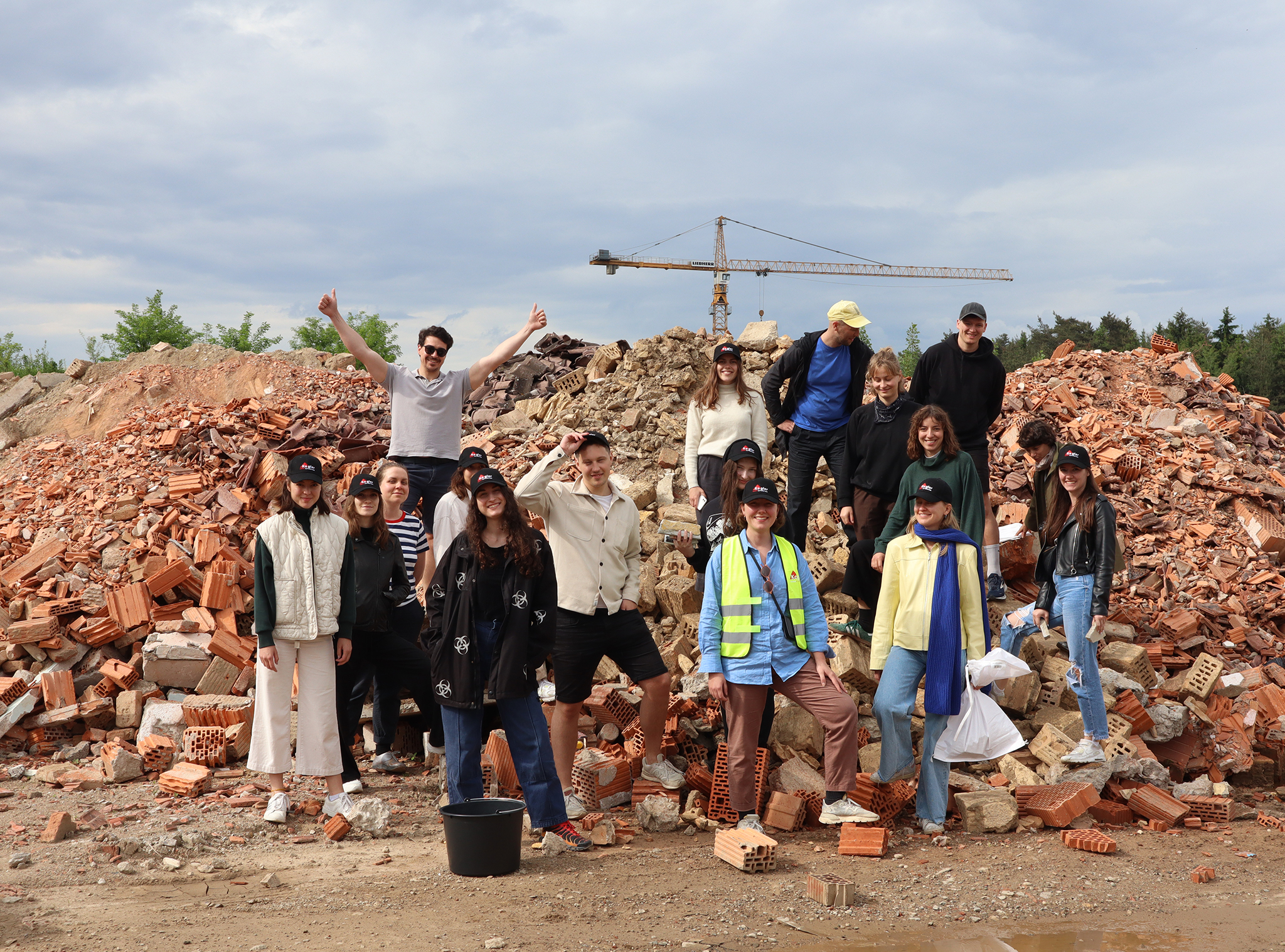
The students of the Institute of Architecture and Design, TU Vienna, with tutors Thomas Amann, Estelle Jullian and Charly Blödel during one of the excursions to GT Baustoff Recycling.
© Charly Blödel, 2022. For more Imprint.
Work Conference – No More Building as Usual: Architecture Beyond Carbon and Greed
On June 24, the Rotterdamse Academie van Bouwkunst hosted the work conference No More Building as Usual: Architecture Beyond Carbon and Greed. Next to plenary presentations by Maria Lisogorskaya (Assemble), Maarten Gielen (Rotor) and Winne van Woerden (Commons Network), five sessions framed open conversations in which the academy community defined several positions that architects and urban designers can take up in the face of eco-social challenges.
Charly Blödel was part of the session of Building Rituals: Circular building, non-destructive construction and regenerative materials are coming to define tomorrow’s architecture. What are the new protocols, values and aesthetics we should get familiar with? With a.o. Estelle Barriol (Studio ACTE), Charly Blödel (Nieuwe Instituut), Maarten Gielen (Rotor), Roxane van Hoof and Claudio Saccucci (Studio Verter), Edgars Jane (KCAP), Laura van Santen (La-di-da) and Sven Schouten (student).
The built environment is one of the largest drivers of natural resource depletion, ecosystem destruction, rising temperatures and more extreme weather conditions, and increasing socioeconomic inequality. Designers and other actors in the production of space play an important role in this and are responsible for developing alternative building practices that help counter these negative trends.
On Saturday June 24 the Rotterdamse Academie van Bouwkunst organised a gathering to discuss new roles that architects and urban designers can take up. How can we give shape to a different planning, design culture and construction industry? How can we learn to have positive footprints before a carbon lockdown goes into effect? What does it mean to approach the (built) environment from a perspective of regeneration? What type of architects do we want to be? And how can we do so in a healthy work culture? We want to explore a way of working that goes beyond the competitive model of individual success and soloist genius, towards one of collaboration around socio-ecological ambitions.
Architect Edgars Jane who participated in the session of Building Rituals reflected on the programme of the conference in his article ‘RADICAL SUFFICIENCY: is this it?’.
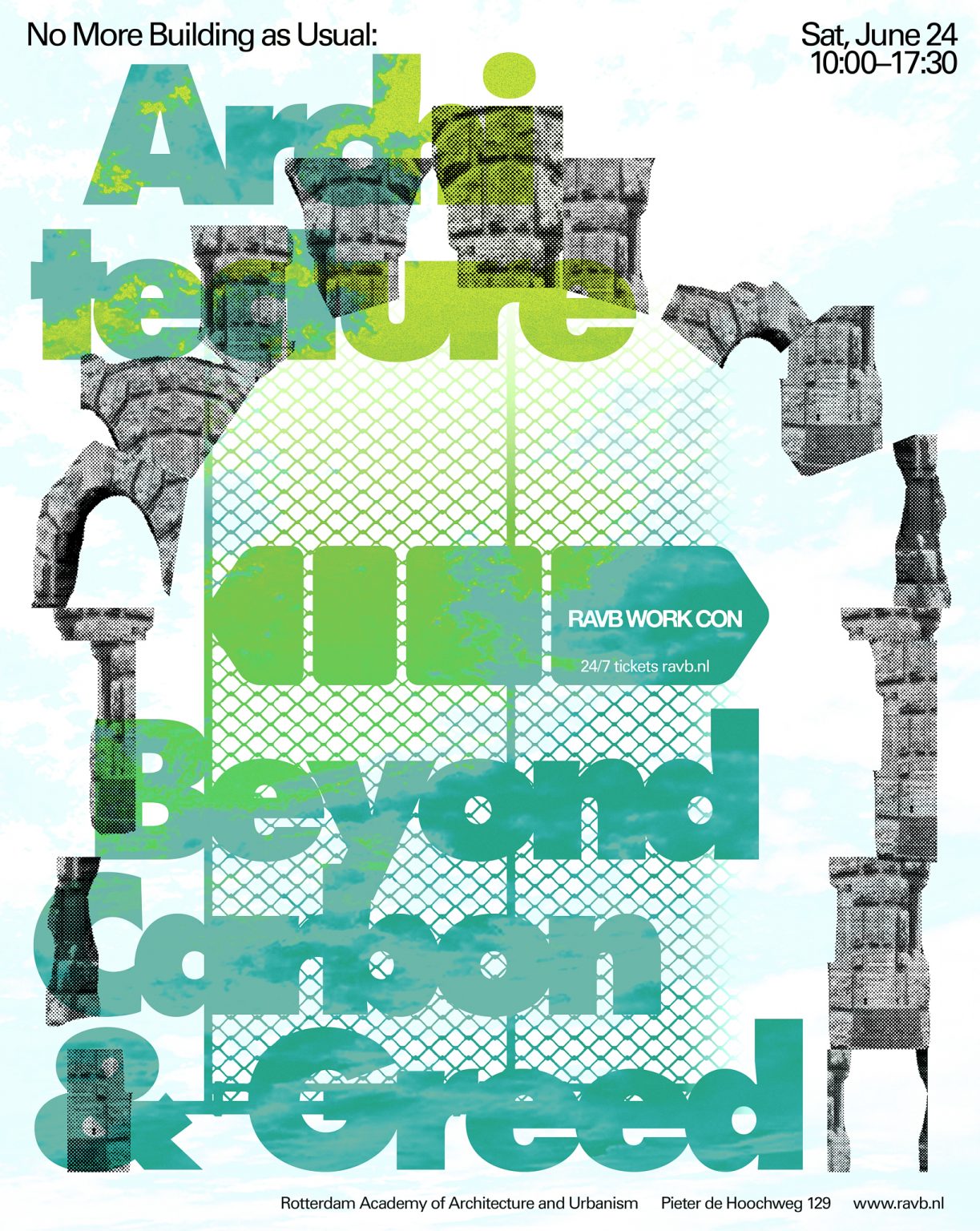
© Charly Blödel, 2022. For more Imprint.
Design studio: One More Time With Feeling
How can we make buildings again from the buildings we demolish? What architecture can we imagine, if fragments, rubble and debris are the main building blocks? The studio ‘One More Time With Feeling’ at the Rotterdamse Akademie van Bouwkunst in Rotterdam proposes reuse as a conceptual approach to architecture and practices of building or un-building. During the semester, large plaster models of generic building structures were made through which the process of demolition was simulated to scale and served as the material basis for making a design.

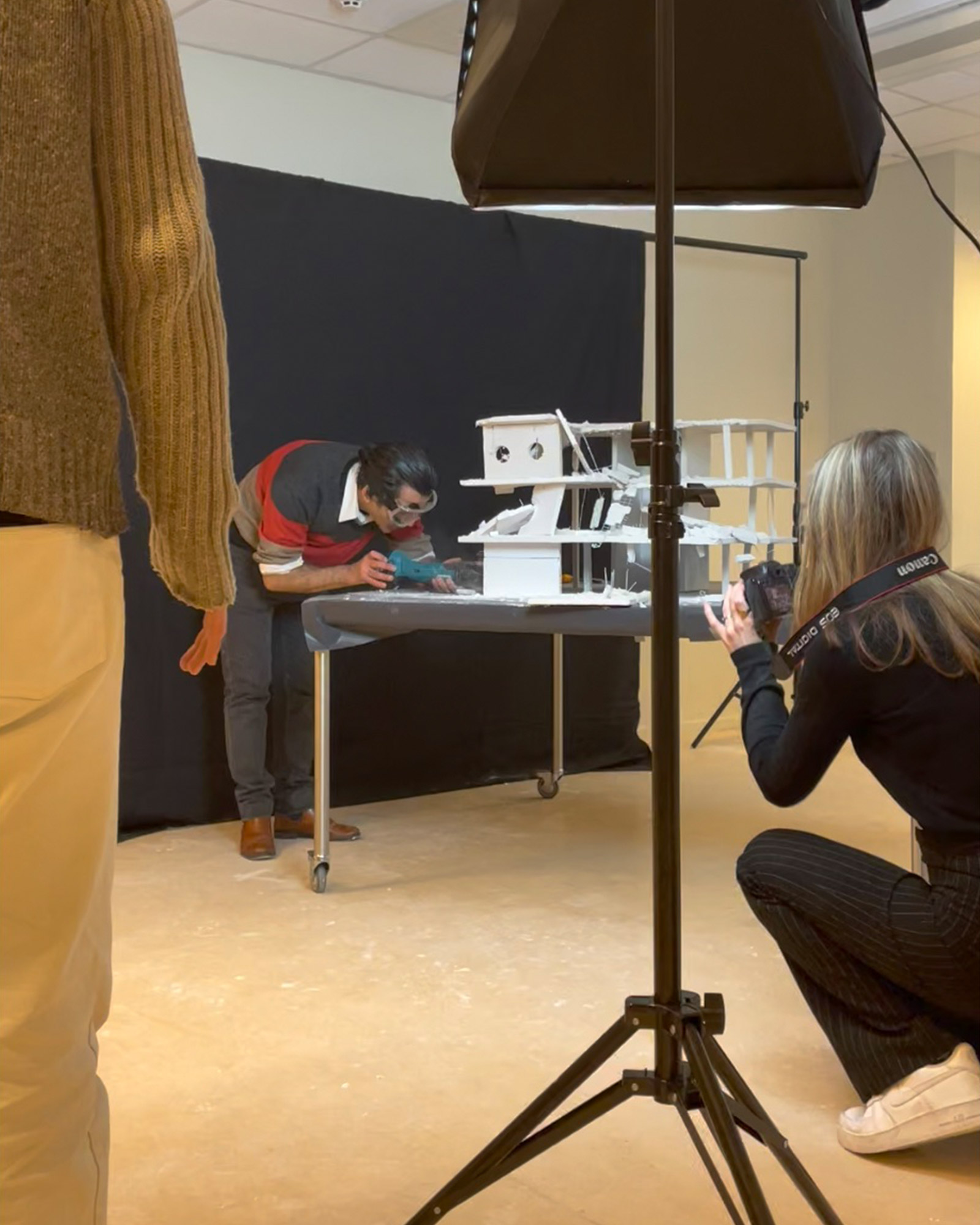
Students
Jurrian Blom, Shamal Soltani, Seyed Farzad Hosseini, Corne bij de Vaate, Joris Warndorff, Jorien Rijper, Elias T’Joens, Anne Spanjaards, Linde Spuijbroek, Merve Coban
Tutors
Tomas Dirrix, Julia Strömland, Charly Blödel, Bas Leemans
Visiting critic
Laura van Santen, Ladida Architects
© Charly Blödel, 2022. For more Imprint.
KLUTZ: (Zoom) Lecture & Open Call
As a prelude to the Architekturwoche Basel 2022, Charly Blödel will give a (zoom) lecture (in German) on 21 April, 17:30–18:30 at FHNW, Basel (CH).
In tandem with the lecture Team KLUTZ launches an Open Call for students to participate in the performative build-up on 6 and 7 May, 2022, at the Basel Pavillon, the main location of the Architekturwoche Basel 2022 where KLUTZ will become a meeting point and forum for panel discussions, interviews and lectures throughout AWB from 09–15 May and summer programme 2022.
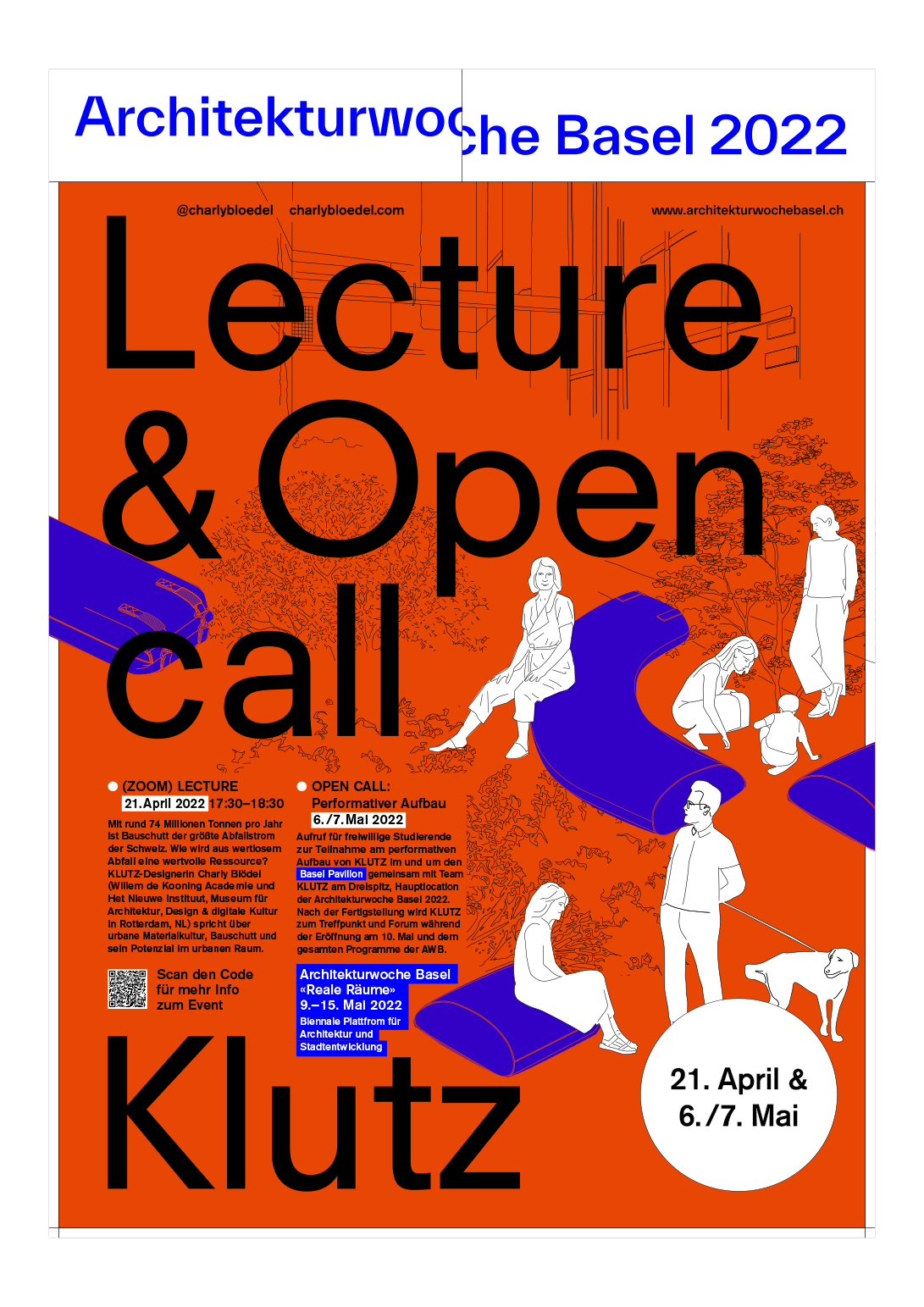
(ZOOM) LECTURE
21 April, 2022, 17:30–18:30
At around 74 million tons per year, construction waste is the largest waste stream in Switzerland. How do you turn worthless waste into a valuable re-source? KLUTZ-designer Charly Blödel (Tutor at Willem de Kooning Academie and programme and exhibition producer at Het Nieuwe Instituut, Museum for Architecture, Design & e-Culture in Rotterdam, NL) talks about material culture, construction waste and its potential to return to the public sphere.
SIGN UP for the lecture via Eventbrite.
OPEN CALL
6/7 May, 2022
On 6 and 7 May, 2022, Team KLUTZ will set up the temporary urban furniture cluster KLUTZ in and around the Basel Pavillon at Dreispitz. We invite student volunteers to join the team in the performative build-up in preparation for the opening of the Architekturwoche Basel 2022. The Basel Pavillon is the main location of AWB 2022. Once completed, Klutz will become a meeting point and forum at Dreispitz during the opening on 10 May and the entire programme of AWB 2022. Team KLUTZ is looking forward to seeing you!
SIGN UP for the KLUTZ performative build-up during the (Zoom) Lecture on 21 April
or directly via mail to hello@charlybloedel.com.
How does worthless waste become a valuable resource? KLUTZ-designer Charly Blödel talks about urban material culture, construction waste and its potential to return into public space. At around 74 million tons per year, construction waste is the largest waste stream in Switzerland. As mixed construction waste, concrete, brick, tile and asphalt are not used to construct new buildings, but are used as secondary materials to fill depleted quarries and other landscape and infrastructure work. Thus, a material that was originally mined from the natural landscape as a valuable raw material now flows back into a man-made landscape as a worthless waste material. How can worthless waste become a valuable resource? This is the question posed by KLUTZ.
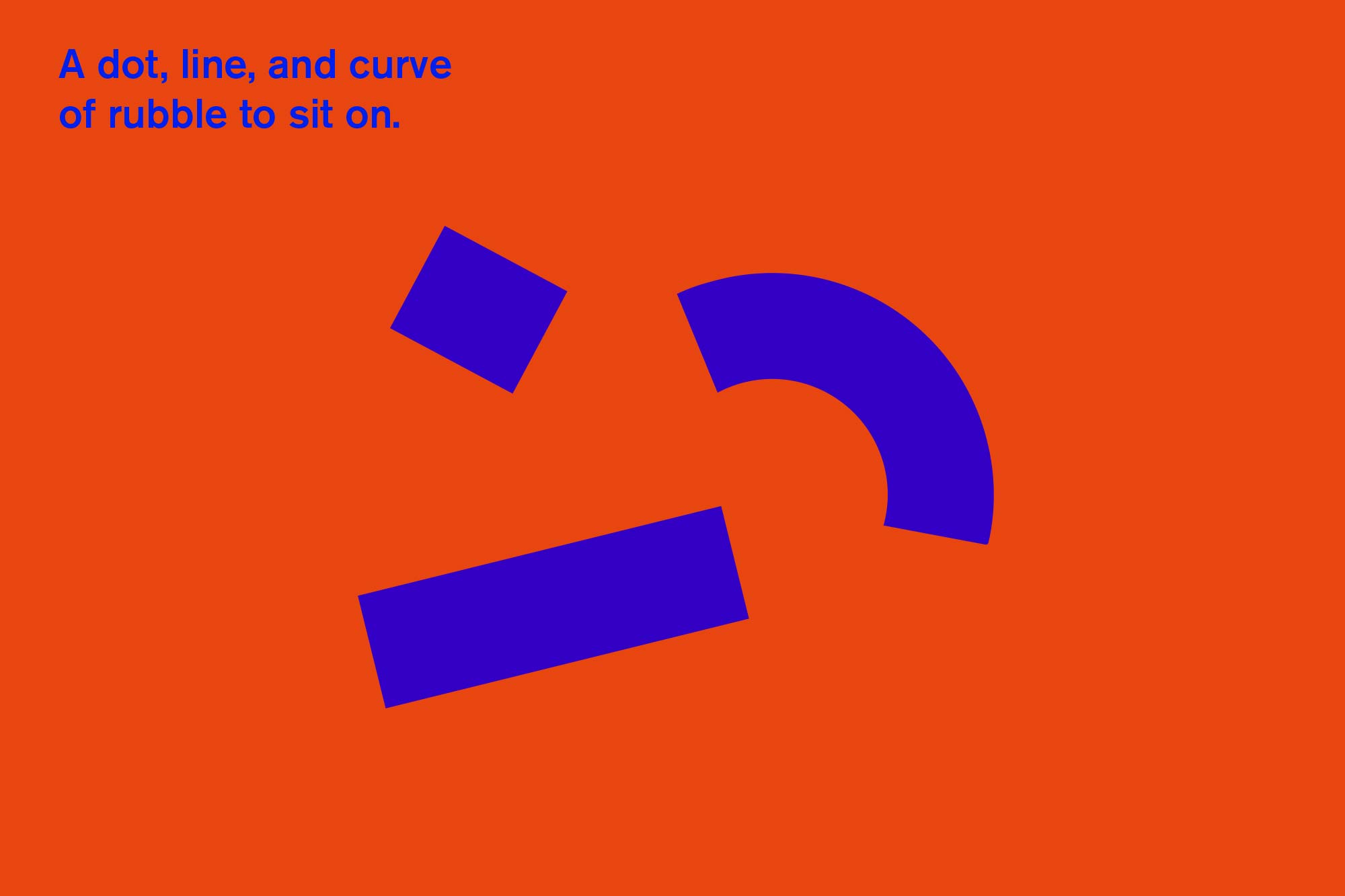
As a bag-module, KLUTZ will provide the context for panel discussions, interviews and lectures at the Basel Pavillon, the main location of the Architekturewoche Basel 2022.
KLUTZ is an urban furniture made of textile, on show for the first time during Architekturwoche Basel 2022. However KLUTZ only becomes a seat when it is filled with construction waste. As a bag module, KLUTZ is easy to transport, empty and refill. This is how KLUTZ travels through different urban contexts. “What’s in the bag?” is the recurring question. In a variety of spatial configurations and mixtures of filling materials, KLUTZ becomes a performative tool to engage with the changing value of the material that our built surroundings are made of.
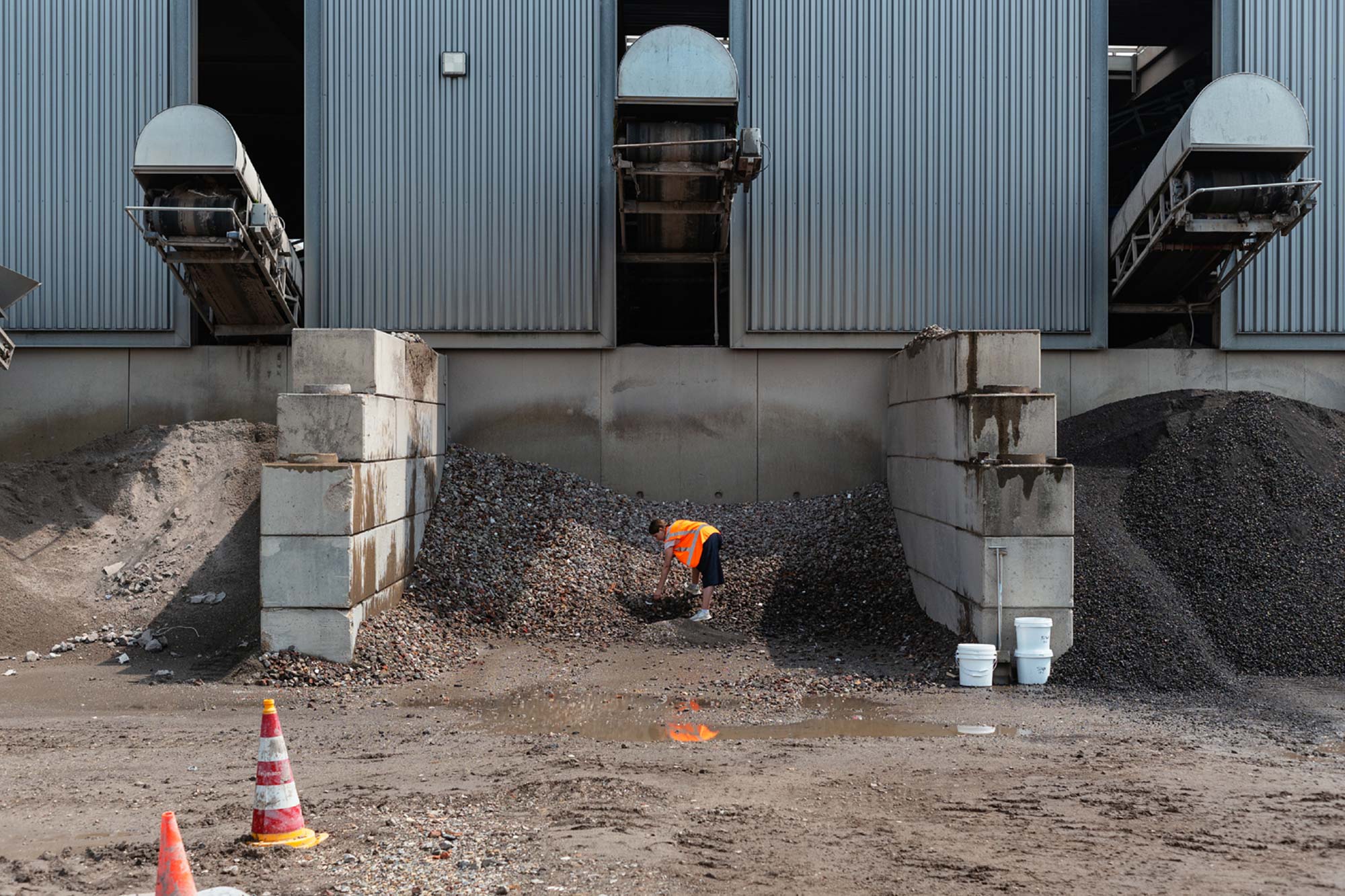
KLUTZ is part of the object family Soft Rubble, a series of spatial constructs in which building rubble and textile find spatial expression sometimes as a wall segment, sometimes as urban furniture. In the project Soft Rubble, which Charly Blödel started during her master studies at the Design Academy Eindhoven (2020), she focuses on the social and ecological implications of spatial design and production systems with a special focus on waste and material culture in the context of the climate crisis.
For more information on KLUTZ at Architekturwoche Basel 2022 and the programme from 09–15 May, 2022, please visit architekturwochebasel.ch
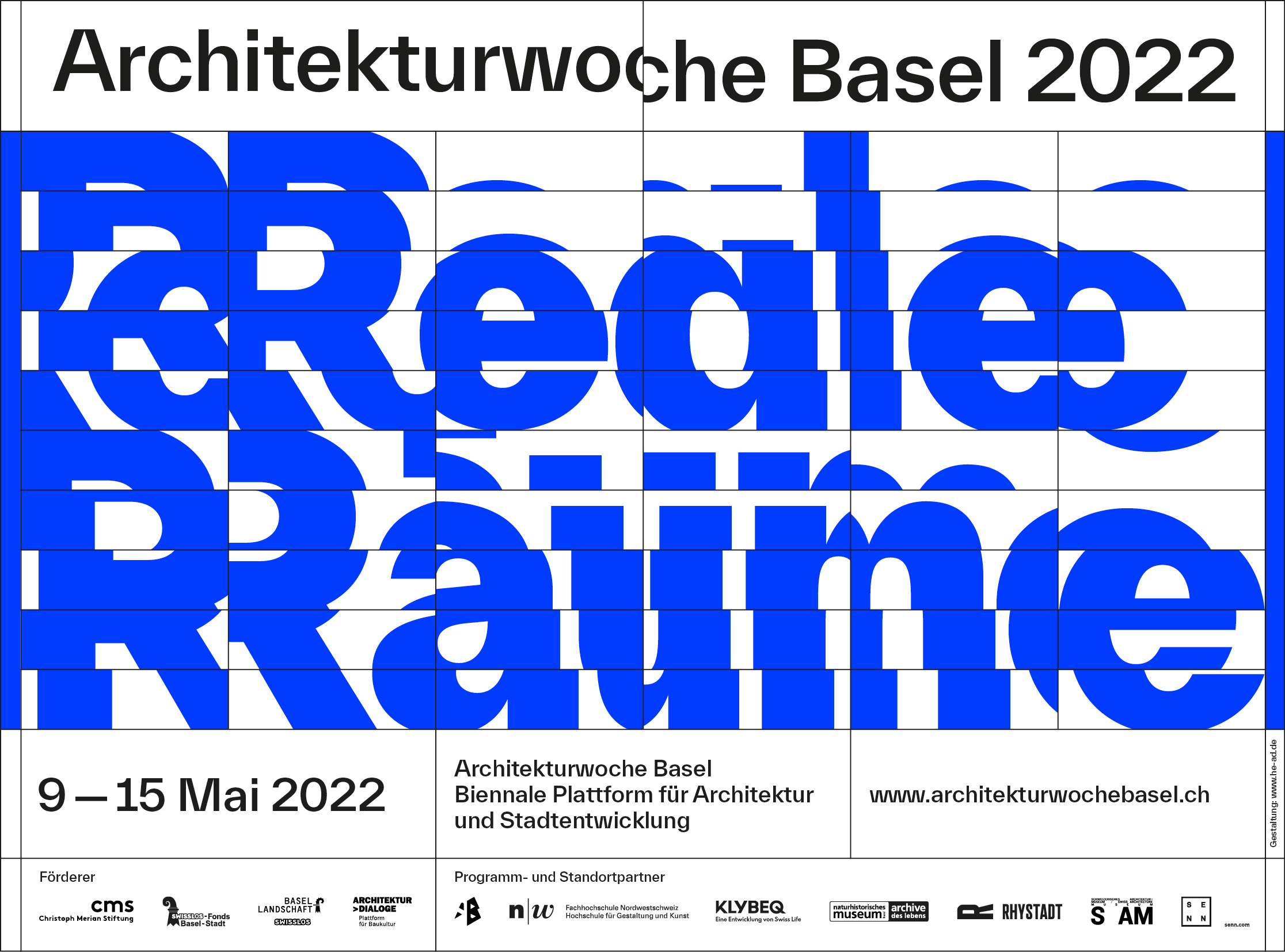
© Charly Blödel, 2022. For more Imprint.
KLUTZ @ Architekturwoche Basel 2022
At around 74 million tons per year, construction waste is the largest waste stream in Switzerland. As mixed construction waste, concrete, brick, tile and asphalt are not used to construct new buildings, but are used as secondary materials to fill depleted quarries and other landscape and infrastructure work. Thus, a material that was originally mined from the natural landscape as a valuable raw material flows back into a man-made landscape as a worthless waste material. How can worthless waste become a valuable resource? This is the question posed by KLUTZ, an urban furniture made of textile and building rubble.
KLUTZ is on show for the first time as part of the Basel Pavillon at Dreispitz, during Architekturwoche Basel from 09–15 May, 2022.
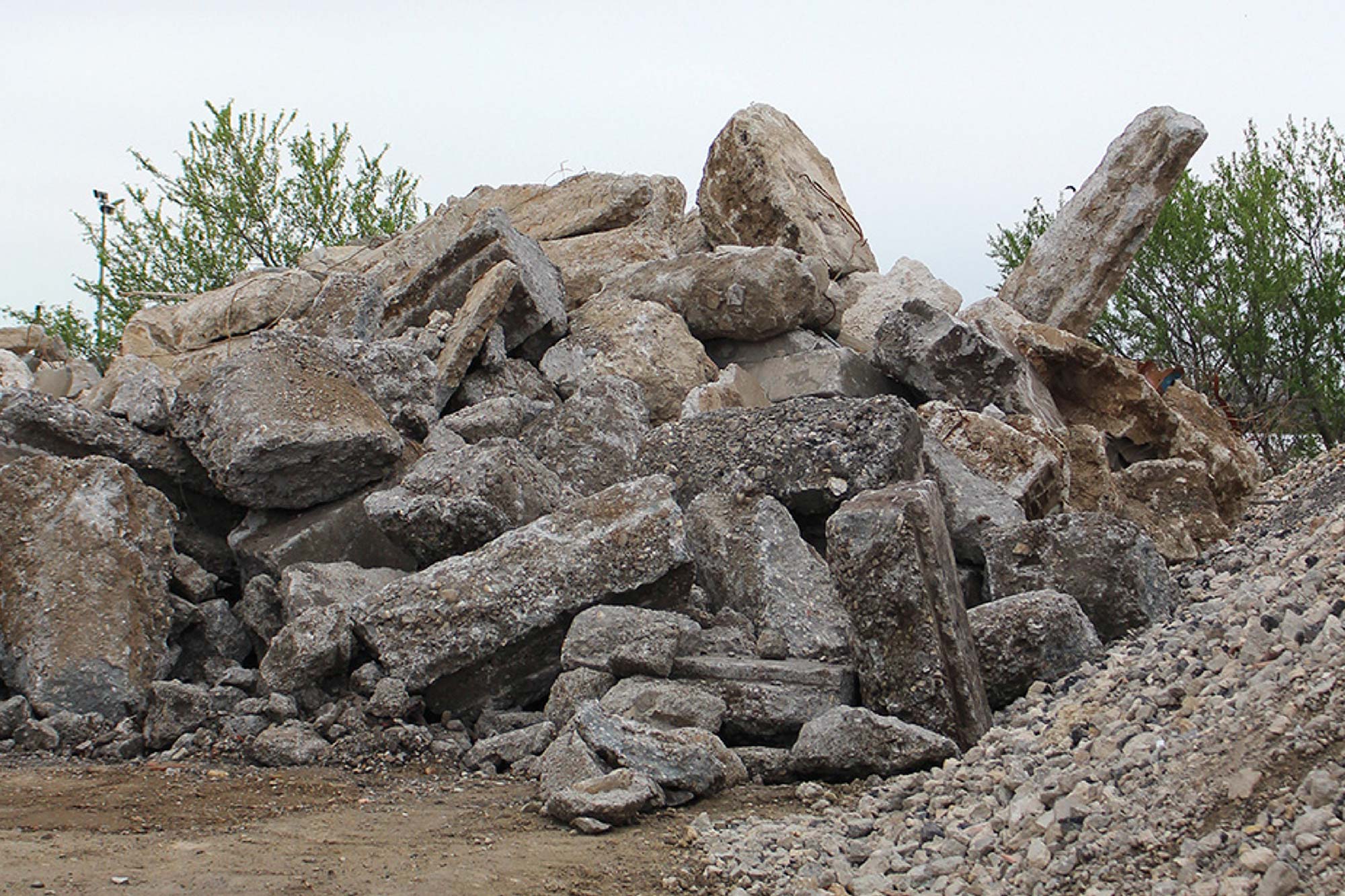
KLUTZ is an urban seating furniture made of textile. But it is only by filling it with construction waste that KLUTZ becomes a seat. As a bag module, KLUTZ is easy to transport, empty and refill. This is how KLUTZ travels through different urban contexts. “What’s in the bag?” is a recurring question. In a variety of spatial configurations and mixtures of filling materials, KLUTZ becomes a performative tool to engage with the interplay of value and valuelessness in urban space.

KLUTZ is built by hand in a performative build-up the start of the architecture week.

As a cluster of bag-modules, KLUTZ will provide the context for panel discussions, interviews and lectures at the Basel Pavillon, the main location of the Architekturewoche Basel 2022.

As a bag-module, KLUTZ will provide the context for panel discussions, interviews and lectures at the Basel Pavillon, the main location of the Architekturewoche Basel 2022.
KLUTZ is part of the object family Soft Rubble, a series of spatial constructs in which building rubble and textile take the spatial form of wall segment or urban furnitures contextual to their immediate surroundings and material supply. In the project Soft Rubble, which Charly Blödel started during her master studies at the Design Academy Eindhoven (2020), she focuses on the social and ecological implications of spatial design and production systems with a special focus on waste and material culture in the context of the climate crisis.
KLUTZ will be on show for the first time at the Architekturwoche Basel 2022 from 09–15 May, 2022 as part of the Basel Pavillon, the main location of the event, hosting panel discussions, interviews and lectures during AWB 2022 and throughout the summer programme of 2022.
For more information on KLUTZ at Architekturwoche Basel 2022 and the programme from 09–15 May, 2022, please visit architekturwochebasel.ch
KLUTZ will be introduced at the (ZOOM) LECTURE: KLUTZ — What’s in the bag? (in German) on 21 April, 2022 at FHNW Basel. Sign up here.
The guided tour around KLUTZ (in German & English) during AWB 2022 will take place on Tuesday, 10 May, 2022 at 14:00–15:00 and 16:00–17:00. Sign up for the tour here.


Basel is recognized as Switzerland’s architectural capital. Hardly any other region is home to so many internationally active architectural offices. In order to showcase the highly diverse potential of building culture, expertise and enthusiasm in the city and surrounding area, Architektur Dialoge has initiated a new biennial platform for architecture and urban development: the Architekturwoche Basel (AWB). The first edition will be held from 9–15 May 2022.

Soft Rubble, wall segment with window and seat, built by Team KLUTZ (2020). Photo: Viktor Hübner
© Charly Blödel, 2022. For more Imprint.
Workshop Emerging Paths in Matera [IT], 2019
Through interviews with locals, international tourists and temporary residents that came to Matera for the duration of cultural capital, six students were guided in the mapping of the temporary transformations and permanent impacts as a result of the capital nomination. Conversations on temporary economical upswings, failed infrastructural redevelopments, homecomers introducing alternative usage to neglected buildings and new narratives forming around over-exposed as well as neglected cultural heritage are a few findings captured in form of a publication and a walking route connecting the changing landscapes of the ancient centre and sleepy periphery.
In response, 6 conversational pieces were built from tufo, the typical local sandstone, under guidance of craftsman Piero Giura Longo. While some put a focus on the changing territory through diverse means of carrying and body movement, others engage with achitectural key features through shape.
In form of a performative walk, these mobile artefacts were carried and pushed along the mapped out path. The students guide immediate neighbours and other local participants with diverse backgrounds through the changing territory contextualising the changing conversations, debate and exchange among the participants.
The workshop Emerging Paths was directed to the Master students at DAE taking place in the summer break from Juli 06th–14th, 2019 at Open Design School Matera. The workshop was developed in collaboration with Roberta Di Cosmo, Edoardo Tedone and Matilde Losi and with participation of Alina Slup and Marek Glogowski.









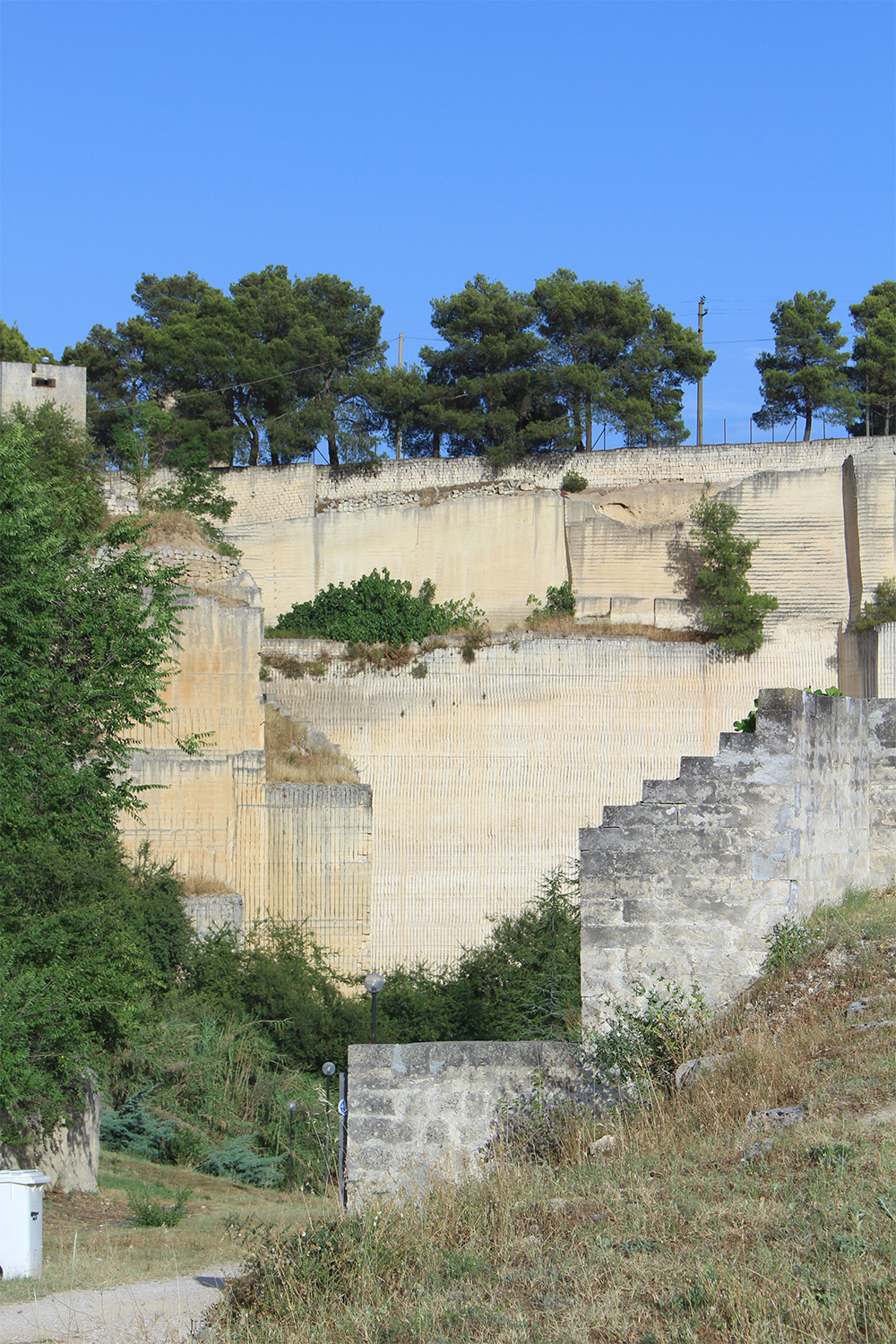
© Charly Blödel, 2022. For more Imprint.
Smails, A Ceramic Set
Part of the Letterhouse Series
The Letterhouse series is a collection of objects that translate the concept of manual letter-writing as a decelerating and unpacking practice in the navigation of fast information.
Smails, along with a foldable writing-paper set and writing desk Raksti, translates this concept of ‘sorting information’ in this case into the language of ceramics. Through its connecting shape, the ceramic set encourages the user to stack the vessels: You stack the dishes and actively free space on the table surface and on your mind.
The Letterhouse series the a Bachelor project developed by Charly Blödel in the Communications design Bachelor department at the Hochschule Mainz in Germany in 2016. The ceramics for Smails were produced under guidance of ceramics tutor Rudite Jecabsone in Babite, Latvia.


»The writer has to write to himself simultaneously, as, through the letter, he will get acquainted with himself.«
Clemens Brentano

© Charly Blödel, 2022. For more Imprint.
Rubble Probes—
Soft Rubble as a Building Process
The publication Rubble Probes explores Soft Rubble applied as a the construction system in the temporary contexts of the urban space in transformation. In form of spatial structures based on historical vernacular typologies, Soft Rubble becomes a tool for appropriation and activation as it inserts itself into the abandoned land plots or disused gaps found across Rotterdam. Assembled by the local neighbourhood by use of local building rubble, Rubble Probes become means to appropriate the temporary square adjacent to on-going construction sites, unused public spaces or as part of temporary cultural programming.
Rubble Probes is a collection of Rotterdam-based narratives of possible application of the textile construction system Soft Rubble. Soft Rubble is a master thesis project developed by Charly Blödel in the Social Design Department at the Design Academy Eindhoven in 2020.

»The Shelter«, based on the jardinu pantescu, the typical enclosed dry-wall gardens for single trees in Sicily




»The Cooler«, based on the yakhchal, the ancient ice pit developed by the Persions 400 BC to store ice in the desert




»The Pod«, based on the Sassi di Matera, the cave dwellings still inhabited today in the Southern Italian city of Matera



»The Windbreaker«, based on the cabane de camargue, rounded, reet-thatched houses positioned in direction to withstand the strong Mistral winds in the Camargue region of France
© Charly Blödel, 2022. For more Imprint.
Essay
The Contemporary Ruin — Material Frictions in Times of Flux
Material studies of material left-overs found in construction containers

WET WALLS
As fortunate as he was to work together with the grand master of modernism, Chilean painter Roberto Matta could not help but disagree with the principles of Le Corbusier. Working as a draftsman in Le Corbusier’s office, Matta rejected his idea of modern architecture as a fusion of the aspirations of classical renaissance architecture with the qualities of accelerating new technologies at the time. In the article of the surrealist magazine Minotaure1 he describes his contrasting ideals as “walls ‘like wet sheets that change shape to fit our psychological fears’, furnished with biomorphic couches that appear in his illustrations to mould to and at the same time threaten to swallow the human body”2. Matta describes his ideas of space as a flexible coat, almost fluid and imperceptible in its alignment with the human body. He portrays a synchronised relationship; two entities moving, intersecting, merging. An architecture rids itself from its material character, the essential “stuff it is made off” as opposed to the monumental and rigid qualities of Corbusier’s renaissance references. An architecture that shows no restraint in adjusting to the needs of its user producing the agility of different modes of usage.
Increasing shifts in the modes of usage of the built environment are a symptom of the continuous forward-facing motion of accelerating progress in our time. Socio-political and economic dynamics in society in the context of greater independence through digital connectivity fuel migrational movements around the globe. Yet, as bodies move at an increased rate, the spaces that they inhabit and leave behind accumulate in contrast to Matta’s scenario where they dematerialise and do not leave a trace3. In other words, the accelerated state of mind and body clash with the perceived ‘slowness’ of material which ultimately culminates in desertion and abandonment of buildings. In precisely this moment, the phenomenon of the contemporary ruin reveals itself. Our surrounding built environment expires much sooner4. It is continuously demolished, transformed, improved and readjusted, dressing the urban landscape in scaffolding. These disruptions tear the urban fabric and its interconnected social life that cannot be patched up as easily as it is dismantled. As these motions of building and removal accelerate, the term ‘ruin’ could receive new meanings: Can architecture only work or not work? Or could it actually be successful in its dysfunctionality? Put another way, could the ruin become productive?

This essay speculates on our relation to the contemporary ruin in the context of the accelerated times we find ourselves in. From the perspective of its static material presence in the fluid terrain of continuous progress it explores the productive potential and societal relevance of the friction that it carries. These accelerated times are what Hartmut Rosa identifies as conditions of ‘dynamic stabilisation’ through which we attempt to navigate the waves of progress.To achieve temporary stabilisation we feel required to push for constant growth, innovation and cultural reproduction of a status quo5. Upsurge of production and social change are the result. We experience these conditions as a feeling of accelerated time. This notion is vividly summarised by Douglas Coupland, co-author of The Age of Earthquakes: ‘The future for me, growing up, was always something that was ahead. In the distance–then it started to get closer. Then it was there, and now suddenly, right now actually is the future. What we’re inhabiting is no longer in the distance anymore but in this state of very, very profoundly accelerating flux.’6 With times in flux and progress inevitable, lifespans seem to become a questionable measurement, leaving the ruin in an ambiguous position.
Elaborating on the term ‘ruin’ words like “vestige”, “remnants”, “trace”, or “relic” come to mind, describing the idea of loss manifesting itself in the decaying traces of a failed utopia. The mere word, ‘ruin’, triggers nostalgia instantly and provokes the unquestioned response of preservation. Walter Benjamin’s definition of the ruin aligns with this notion in the sense that it is an object-trace capturing ‘nature in a petrified state to nature in a permanent state of transition’7. Nonetheless, Benjamin limits the value of the ruin to its documenting, capturing capacity and implies a need for maintaining this ‘petrified state’ to secure its meaning. This makes Benjamin’s ruin inaccessible as we have to keep a secure distance. By extension, it leads to the problematics of preservation—as we cannot sustain everything, what is worth keeping and who decides such matters?

ENDING POINT: SYSTEM
Dutch architectural firm OMA thematises the problematics of preservation in their masterplan for La Deféncein Paris. La Défense is one of the main business areas in Paris, that was bound to be expanded in 1991. As a proposal for this undertaking, OMA produced a scheme, causing a stir at the time, that rather than imposing another superstructure onto the dense area to focus on what lies beneath8. From the point of view of statistics, most of the current buildings would reach the end of their life span within the coming 20 to 30 years which would bring to light very naturally a tabula rasa, a blank slate, free of contextual conditioning. In anticipation of this emergence, OMA planned for the continuous revealing of an underlying grid that is the basis for not only the existing but also the extended areal of La Défense. In their proposal, they criticise that in Europe as “the Old World, the ‘continent of history’, there is an unspoken assumption that all its substance–even the most mediocre–is historic, and therefore has the right to eternal life.”9 “Mediocre substance” is what OMA’s masterplan categorises as recently erected buildings, doomed to imminent expiration and demolition or in other words—the contemporary ruin to be.
La Défense is a celebrated example of city planning. The role of the architect: patience. The elegant removal or “unbuilding”, is what Keller Easterling calls ‘perhaps the only subtraction project in recent memory that is prominent enough to be awarded a Pritzker equivalent for building removal’10. What her evaluation alludes to is that the existing buildings are acknowledged in their life cycles. Progress is registered as the driving force behind expiry and translated into a system bringing forward the new. Nonetheless, this system maintains the ruin clearly as an ending point. It restricts its potential to removal in order to unlock the possibility of a fresh start hidden underneath.
While Benjamin sees the value of the ruin in its preservation and OMA in its removal, an alternative that mediates between the two becomes very interesting, as both options are questionable in the face of global resource shortage and current carbon footprint of the building industry. So, how can we not merely cope with but take advantage of the material qualities of the ruin? How could the friction between the physicality of the expired building and our mind be a fruitful one? Svetlana Boym provides an insightful view of possible scenarios in her analysis of ruins. In her opinion, ruins do not only portray “a romanticising notion of the past layered with a contemporary reflection of our inner landscapes” but prove to be “sites for a new exploration and production of meanings”11. Boym lifts the heavy layer of dust. Interaction becomes possible and in this case crucial.

ENDING POINT: COMMUNITY
A project that makes use of building removal beyond the recovery of a blank slate, is A Way, Away [Listen While I Say]. The project taking place over several months in 2017 in St. Louis, Missouri, centred around the activation of an empty land plot and an adjoining building that would be demolished in the course of the project. Chicago-based artists Amanda Williams and Andres Hernandez choreographed the process of taking down the building as a community process in five phases of “Marking”, “Subtracting”, “Translating”, “Shaping”, and “Healing”12. The process was initiated by painting the complete building with golden paint to articulate the focus of the conversation. Throughout the documentation and retrieval of building materials from the demolition, the community made proposals and guided their use in the transformation into a green space for the city.
A Way, Away demonstrates how the ruin, given the time, can be opened up to a civic process to evaluate and formulate collective adaptation in a bottom-up manner when progress triggers urban transitioning and calls for new schemes. In engaging of the community throughout the process, Willians and Hernandez cultivated reflection and assessment of the life cycle of the urban landscape. However, in this case the developed conclusions were left without major impact on the previously planned park that eventually replaced the demolished building. The insights articulated meanwhile could not be channeled back into the planning process as the new plans had already been finalised.
Even though A Way, Away shows the potential of a ruin still in relation to its removal, it yields another insight. As a building is abandoned, it is removed from the market and the original financial envelope it initially emerged from. The ruin, as it has moved beyond the gaze of the market, does not have to function within its system of regulations anymore. In minimal periods of time, expired buildings can outline what is needed. Spaces are adjusted radically and rudimentarily to find quick solutions for temporary adjustments. In this sense, architecture takes the shape of a practice or performance as opposed to a scripted scheme. What seemingly lies in decay can become a 1:1 testing ground for conclusions such as the ones outlined by the community in St. Louis. This practice reminds of Matta’s image of ‘walls like wet sheets’ changing and morphing to the body’s motion With life re-entering into its deserted spaces, the ruin can be seen in a different light, posing the question: Could the ruin be reevaluated to be not seen as an ending point but become an actual starting point?

ENDING POINT: RUIN
Sans Souci Community Cinema in Soweto, South Africa shows what this notion could look like. In 1995, the Sans Souci Community Cinema was destroyed in a fire. In 2002, Lindsay Bremner and 26’10 South initiated its reconstruction through concept development from the spatiality of the ruin itself. Instead of speculating on the potential of the ruin, its capability to sustain a variety of functions was rendered tangible through open-air screenings, installations, performances, workshops and festivals13. This way the transformation was envisioned on-site, anchoring the future building at the heart of its community. Furthermore, the programme helped promote and raise a budget for reconstruction. Following a very successful campaign and further developments in the realisation of the generated proposal, heavy rainfalls led to the partial collapse of the remains of the building.
Nonetheless, the project is a strong case study for the ruin activated as a testing ground. In this sense, Sans Souci Cinema shows that the ruin today can exceed the role of “new exploration and production of meaning” (Boym) which remains on the theoretical level. It has the capacity to metamorph from an ending point of a life cycle into a starting point for the transformation of urban texture within specific local contexts.

RUIN AS NAVIGATION
OMA’s scheme for La Défense stopped at defining that buildings have shortening lifespans and applying this notion as a system. The project of A Way, Away shows how a community can be a driving force in the development of the built environment and foster a culture of engagement and initiative. Deconstruction becoming a civic process. Sans Souci Cinema develops this aspect further as the ruin then is transformed into a 1:1 testing ground to help reflect on past concepts to develop new ones. The ruin itself becomes a process. In this way, less defined areas in the regulated pattern of the urban landscape provide a fertile ground to become a thermometer of the relation between progress and inherent social change, emerging needs and necessary actions. Seeing the connections with buildings and how and why they do or do not work can let them have an influence and shape established architectural practices.
Now progress can be observed manifested on all scales throughout our daily paths and destinations. We see “with half-closed eyes, an accelerated time-lapse within which large swaths of building and landscape seem to be simultaneously cultivated and harvested or built and unbuilt”14, Keller Easterling describes. Yet buildings carry with them much more than the bare weight of their compiled building materials and are much harder to remove in concept as in practice. They do not decompose without a trace. They do not only answer to a grid that is drawn by an urban planner but also to the much more organic grid of appropriation by use of its community. Buildings, from their inception to their removal carry the stories that render the social tissue that holds and makes the built environment habitable.
The picture of ‘walls like wet sheets’ that Matta paints, seems to come very close to Easterling’s suggestion of ephemerality. Yet, the fluidity that he describes is of a different kind. It describes space that registers and is aware of the human being, is connected almost physically, lets itself be shaped and helps shape through productive friction. This fluidity asks for interaction, engagement and active shaping. From this perspective, the ruin moves beyond a mere milestone or an anchor point to navigate and position yourself against. The ruin is reconfigured from an endpoint into many possible new beginnings. As such, it can provide a fertile ground for cyclic motions of iteration, testing and evaluation on an urban scale. It can help form fluid, spatial narratives centered around an evolving ’social architecture’ as opposed to the remoteness and perceived slowness of conservative planning and construction practices. Positioned as such, the ruin gains a key role in the critical approach to, and navigation of continuous waves of progress in the extreme present.

1‘Mathématique sensible—Architecture du temps’, Minotaure, Paris, no.11, May 1938
2 Attlee, James (2007). Towards Anarchitecture: Gordon Matta-Clark and Le Corbusier. Retrieved from https://www.tate.org.uk/research/publications/tate-papers/07/towards-an-architecture-gordon-matta-clark-and-le-corbusier#foot- noteref26_a6tj2o5
3The notion of a tendency towards dematerialisation manifests itself in the continuous digitalisation of major parts of our lives, such as money through contactless payment, social interactions through digital networks, etc. yet hits firm limitations in the built environment. Our struggle with these limitation reveals itself on different levels such as the nomadic lifestyle being celebrated and articulated in the success of Airbnb, the home wherever you come to be, or the emergence of workspaces harnessing the creative, entrepreneurial industries all over the world. Furthermore, the need of space limited in time reveals itself in the extended application of cutting-edge technology such as large scale 3D-printing from bio-based materials such as the exhibition pavilions and cabins by DUS Architects such as the “Tiny [Bau]haus” stationed temporarily at Het Nieuwe Instituut in Rotterdam, The Netherlands. (See the website of DUS Architects here: https://houseofdus.com) The “Tiny [Bau]haus” is a cabin constructed from 3D-printed elements from bio-based plastics, creating a space that can easily be disposed of after travelling Europe for a year. (See the introduction to the Tiny [Bau]Haus on the website of HNI, Rotterdam here: https://neuhaus.hetnieuweinstituut.nl/curriculum/tiny-bauhaus)
4The term ‘expiry’ returns several times throughout the essay. What is meant by expiry is, that the building stops being used in the way or loses the context that it was initially planned for. Buildings today expire in their original purpose after around 20 to 30 years as described in OMA’s masterplan for La Défence that is discussed further along. (See OMA (2018). Mission Grand Axe. Retrieved from https://oma. eu/projects/missiongrandaxeladefense) Furthermore, the research of architect Jenny Bevan has shown that this estimated time until buildings generally expire continuously shortens. Each decade, we can expect the buildings that are being newly built to have a life span ten years shorter than the previous decade. (See Bevans TED Talk on “Our Disposable Architecture” here: https://www.youtube. com/watch?v=7OLsIvyFi8&t=60s&frags=pl%2Cwn) A curious thought, what will happen when the life span of a building in this sense moves into the negative from 2030 on.
5 Wajcman, Judy & Dodd, Nigel (2017) The Sociology of Speed. Oxford: Oxford University Press.
6Jones, Charlie R. (2015). Inside The Age of Earthquakes. Retrieved from https://www.dazeddigital.com/artsandculture/article/24283/1/inside-the-age-of-earthquakes
7Gómez Moya, Cristián (2011). Ruins. Retrieved from http://monumenttotransformation.org/atlas-of-transformation/html/r/ruins/ruins-cristian-gomez-moya.html
8OMA (2018). Mission Grand Axe. Retrieved from https://oma. eu/projects/missiongrandaxeladefense
9OMA (2018).
10Easterling, Keller (2014) Critical Practice 4, Subtraction. Berlin: Sternberg Press.
11Boym, Svetlana (2011). Ruinophilia: Appreciation of Ruins. Retrieved from http://monumenttotransformation.org/ atlas-of-transformation/html/r/ruinophilia/ruinophilia-apprecia- tionofruinssvetlanaboym.html
12 Fleischmann Brewer, Kristin (2017). Between Precarity and Possibility. Retrieved from https://www.awayaway.site/blog/betweenprecarityandpossibility
13Spatial Agency (–). Sans Souci Cinema. Retrieved from http://www.spatialagency.net/database/sans.souci.cinema
14Easterling, Keller (2014) Critical Practice 4, Subtraction. Berlin: Sternberg Press.
© Charly Blödel, 2022. For more Imprint.
